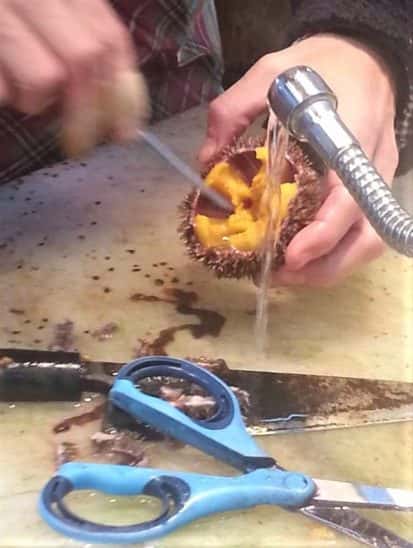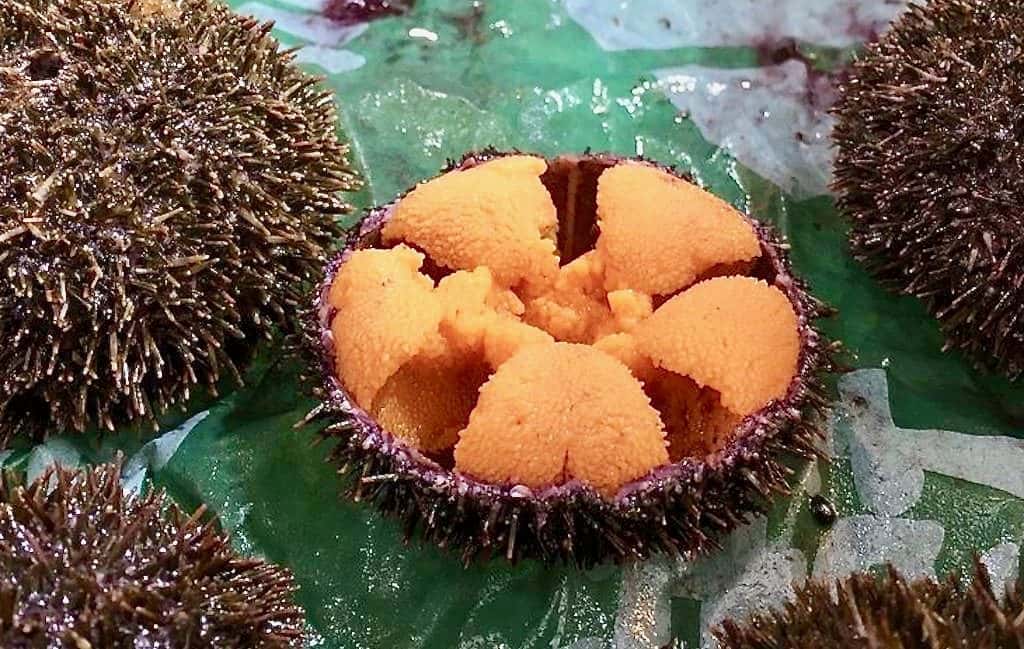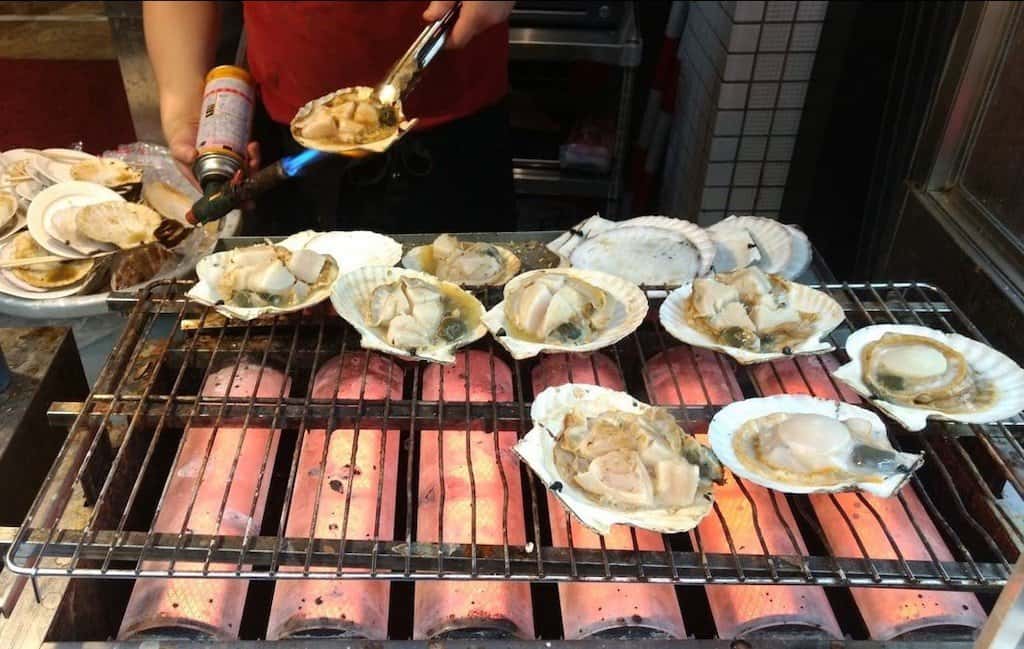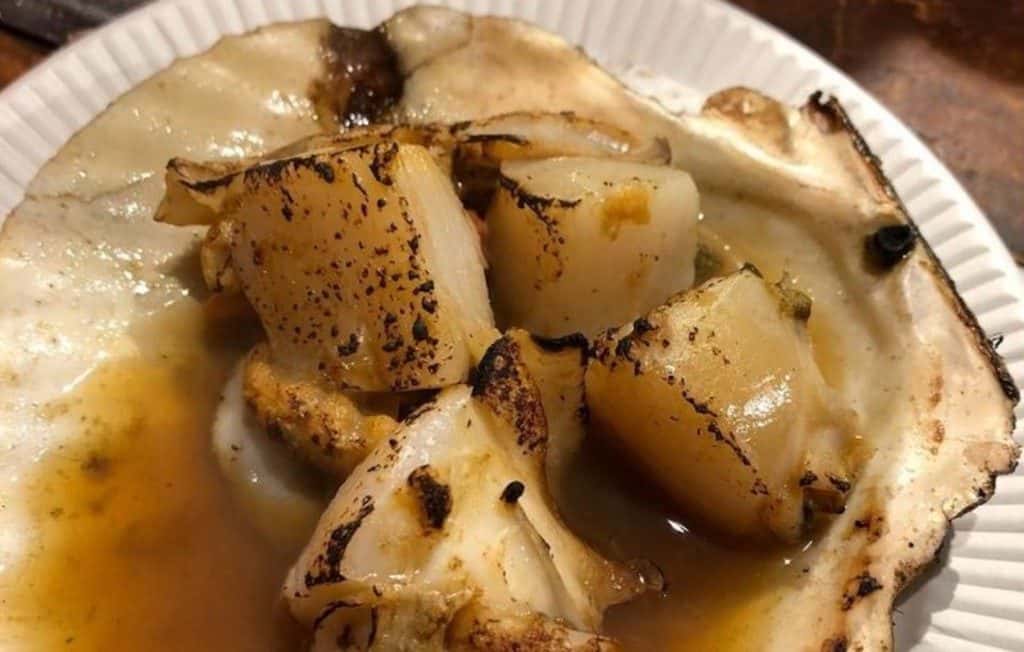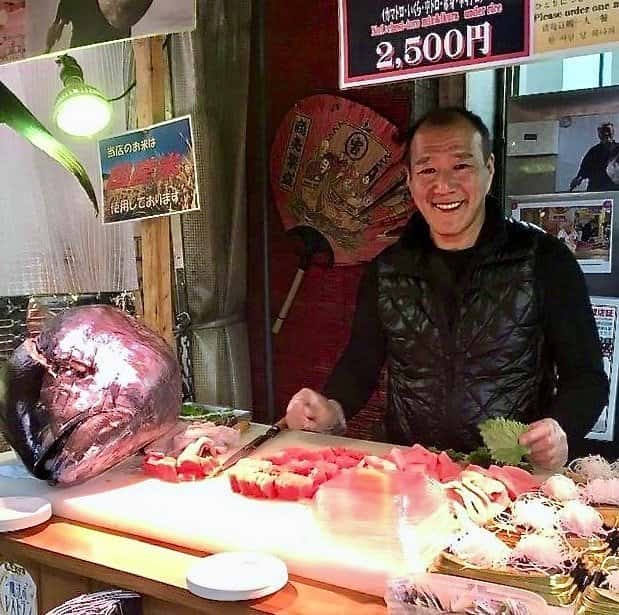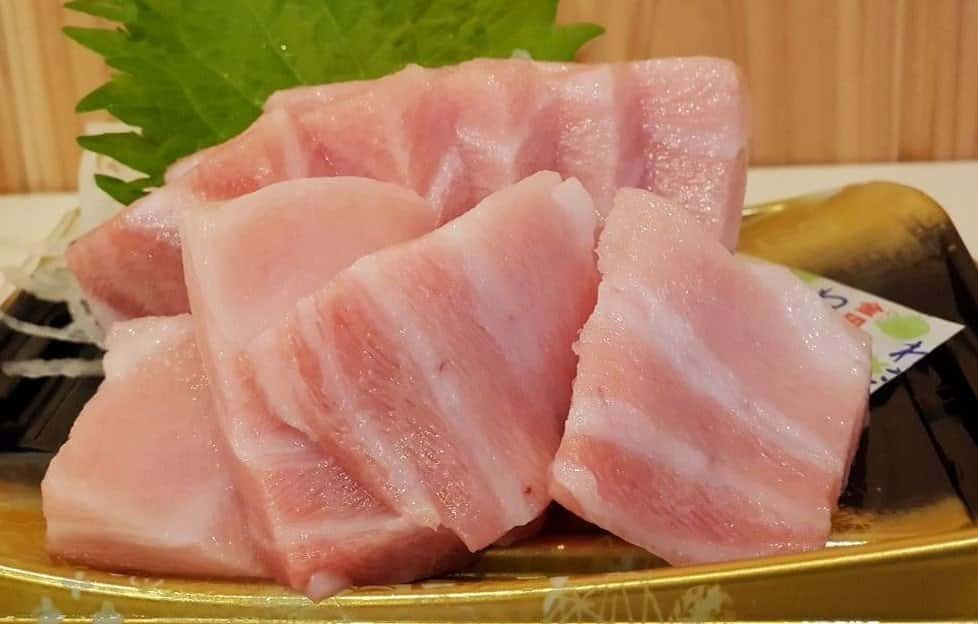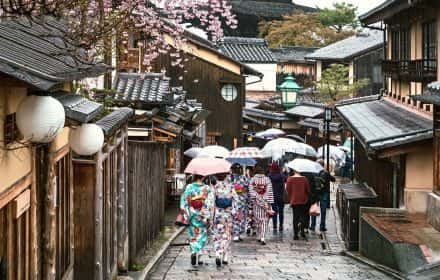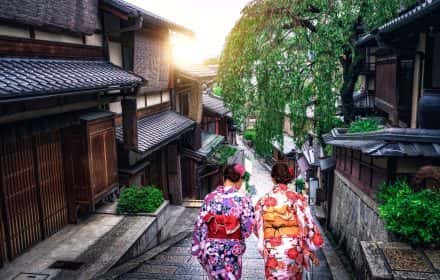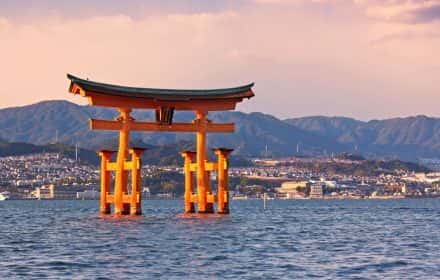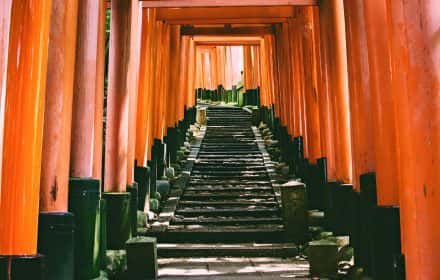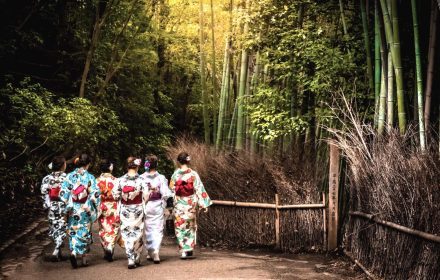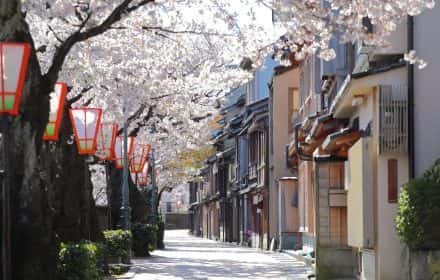This site uses affiliate links, meaning that if you make a purchase through our links, we may earn an affiliate commission.
There are many incredible places around Kyoto that can be easily explored for just a day. Continue reading and find out what are the best places you can visit on day trips from Kyoto.
Are you spending a couple of days in Kyoto? Follow this guide for the perfect 2-day itinerary in Kyoto that covers 8 major attractions in Kyoto that should be on your Kyoto bucket list.
If you are looking for more ideas for things to do in Kyoto, then take a look at 11 Things to Do in Kyoto. It is a complete Kyoto bucket list that will make you wish you had more time reserved for Kyoto.
How to Go on Day Trips from Kyoto
It is super easy to go on day trips from Kyoto by using public transportation. The buses, trains, and subway will get you fast to all the amazing places around Kyoto. And, there are always several ways of getting to a particular place!
- Trains
Kyoto has 6 train lines and consists of the national JR Line and several local private lines. If you have a JR Rail Pass, then you will definitely want to use JR trains while going on day trips from Kyoto!
You can download a free English-language PDF of Kyoto’s train system here.
- Subway
The Kyoto subway system is composed of two lines: The north-south Karasuma Line and the east-west Tozai Line. These two lines intersect in the middle of Kyoto, allowing you to transfer lines.
Make sure to download a free English-language PDF of Kyoto’s subway system here to help you navigate Kyoto by the subway system.
- Buses
The bus system is extensive in Kyoto is extensive, and honesty, you can get almost anywhere by bus around Kyoto.
Download Kyoto’s bus system map with Kyoto’s major attractions here.
From personal experience, I think you will find trains and the subway easier to use especially if this is your first time going on day trips from Kyoto. However, once to take a bus a couple of times, you will be quite comfortable using it.
If you would prefer to explore areas around Kyoto at a leisurely pace, then what you need to know is that there are some day trips from Kyoto that can be done by bike.
It is super easy to rent a bike in Kyoto and my recommendation is that you check out the Kyoto Cycling Tour Project for the best prices and best quality bikes.
Where to Stay in Kyoto
- Stay in Downtown Kawaramachi
The best area to stay in Kyoto is Downtown Kawaramachi. It offers plenty of restaurants and shops, and to top it off, it is just a walking distance of Gion. Plus, plenty of public transportation options.
My favorite place to stay is Kyoto Shijo Takakura Hotel Grandereverie. The location is perfect right in the heart of Kyoto (0.6 miles from Gion Shijo Station and a 15-minute walk from Kyoto International Manga Museum).
You will love everything about this place. The staff is so accommodating and extremely polite. The cleanliness of the rooms is top-notch. The breakfast is yummy and healthy.
Another place that I want to recommend is Good Nature Hotel Kyoto. Again, great location: a 5-minute walk from Gion Shijo Station and 0.8 miles from Samurai Kembu Kyoto, 1.3 miles from Sanjusangen-do Temple, 1.4 miles from Kiyomizu-Dera Temple, and 1.6 miles from TKP Garden City Kyoto.
Just an awesome hotel! You will love everything about it. The hotel is modern and beautifully designed. The rooms are super clean. The bedding and linens are always crisp and smell fresh. All the bath products are lovely and organic.
- Stay Around Kyoto Station
Another excellent area to stay in Kyoto is anywhere around Kyoto Station. It is super convenient and all your public transportation options are in one spot.
The one place that I am recommending you check out is The Thousand Kyoto Hotel. The Thousand Kyoto Hotel is another one of my favorites! The location is awesome, with the absolute cleanliness, super comfy bed, and fresh, crisp linens, fabulous breakfast, professional staff that will go out of their way to make your stay comfortable, you cannot go wrong with booking this hotel.
Best Time to Go on Day Trips from Kyoto
Kyoto and all the places that you can visit on a day trip from Kyoto are awsome to explore at any time of the year. The climate is temperate, which means that it does not get super hot or extremely cold.
- However, the best times to visit Kyoto are October/November (fall) and March/April/May (spring). Needless to say, the changing leaves in the fall are beautiful and the cherry blossoms in the spring are stunning.
- The summer months (June/July/August) in Kyoto can be hot and humid.
- The winter months (December/January/February) in Kyoto are usually fairly cold.
7 Fun and Easy Day Trips from Kyoto
Day Trip from Kyoto to Miyajima Island
If you are looking for a day trip and a little adventure, then Miyajima Island, the “Island of Gods” is a perfect day trip from Kyoto.
Miyajima is home to the revered Itsukushima Shrine, the iconic Floating Torii, an impressive 5-story pagoda, plus it offers a wide range of fun activities like taking the ropeway to the top of Mount Misen, meeting Miyajima Island deer, and trying some local delicacies.
How to Get to Miyajima on a Day Trip from Kyoto
Before we dive into how to get to Miyajima from Kyoto, I want to recommend that you get JR Pass before traveling to Japan. It will save you a lot of money! You can buy it here.
If you have JR Pass, then take the Shinkansen Hikari from Kyoto to Shin Osaka in Osaka.
From Osaka at Shin Osaka, switch to Shinkansen Sakura for Hiroshima. The trip takes around 1 hour and 50 minutes.
Next, once you reach Hiroshima, take the JR Sanyo Line for Iwankuni to travel to Miyajimaguchi. The journey time is just under 30 minutes.
Finally, at Miyajimaguchi take the 10-minute JR Miyajima Ferry to the island.
If you do not feel comfortable using public transportation, then my recommendation is to book a 1-Day Hiroshima and Miyajima Tour (Round-trip from Kyoto). It covers both, Hiroshima and Miyajima in one day. You will have a licensed tour guide by your side the entire day.
What to See on Miyajima Island on a Day Trip from Kyoto (3 Top Things You Can't Miss)
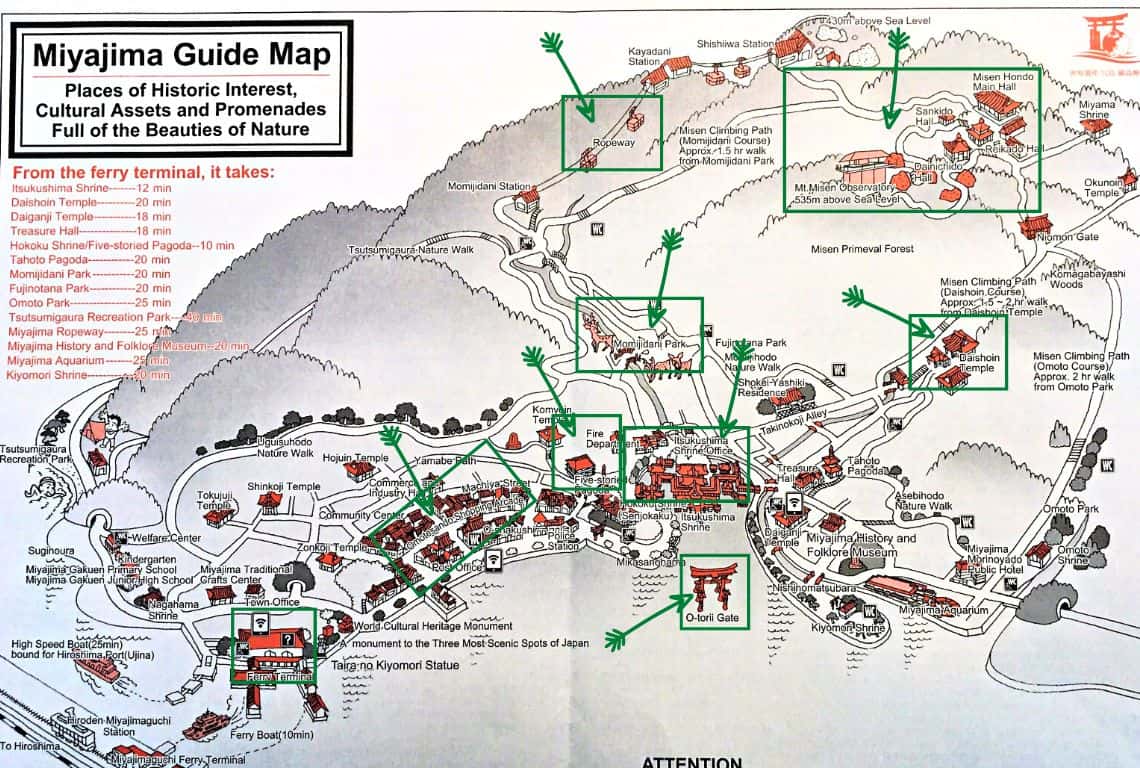
Map of Miyajima Island / Image Credit: Miyajima Tourist Association / Day Trips from Kyoto
In this post, I listed 3 top things to do in Miyajima. However, there is so much more to do on the island. If you look at the map above, I marked all the places worth exploring on Miyajima.
For a complete list check my post: Perfect Day Trip to Miyajima from Kyoto, Osaka, or Hiroshima (9 Things to Do)
1. Be in Awe of Giant Floating Torii
The number one attraction as well as the symbol of Miyajima Island is the Giant Floating Torii. During the high tide, it appears as if the torii is floating out in the sea.
Interestingly enough, unlike the traditional torii, which consist of two pillars, the Miyajima Island torii has an additional four supporting pillars. All in all, it weighs about 60 tons and stands almost 17 meters high.
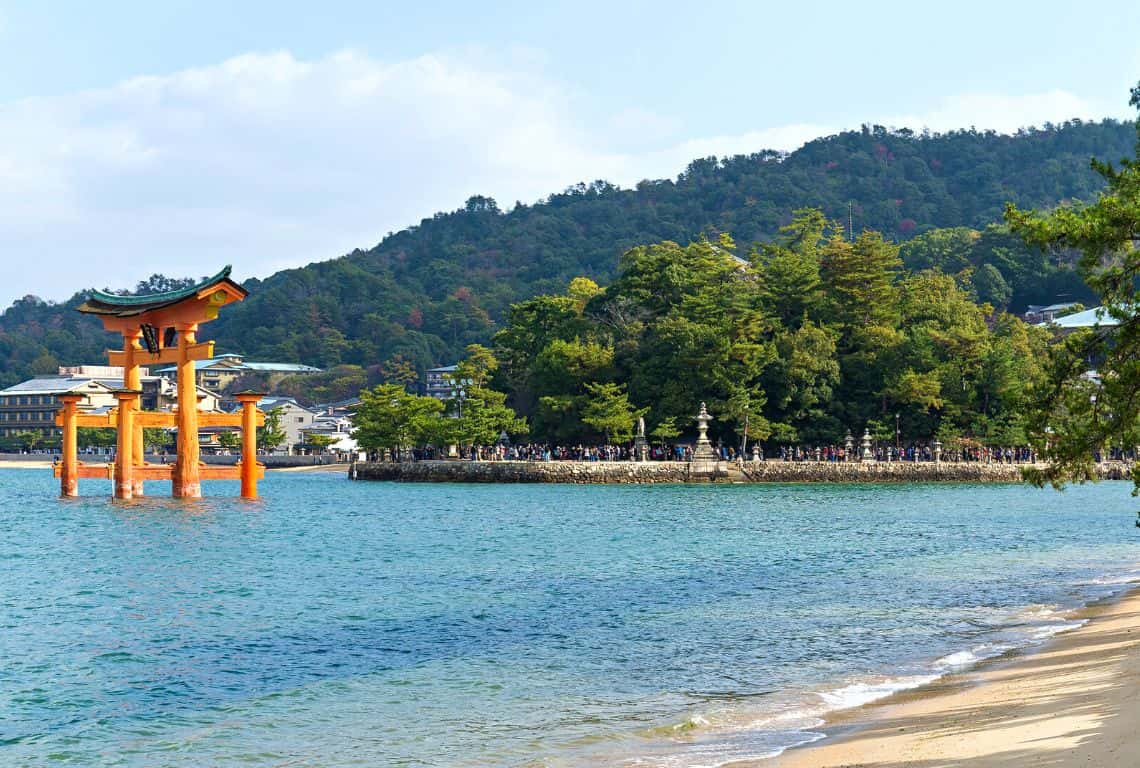
Giant Floating Torii in Miyajima/ Day Trips from Kyoto
2. Explore Itsukushima Shrine
Itsukushima Shrine is absolutely stunning. The shrine was built in 593 and became an important place of worship in about 1168. In 1996 the World Heritage Committee officially inscribed Itsukushima Shinto Shrine as a World Cultural Heritage.
All the sections of the shrine are connected by numerous boardwalks and supported by pillars above the sea. During the high tide, the shrine looks as if it is floating in the Seto Sea.
Interestingly enough, the reason why the shrine was built out in the sea was that the island was originally thought to be too sacred for commoners to set foot upon.
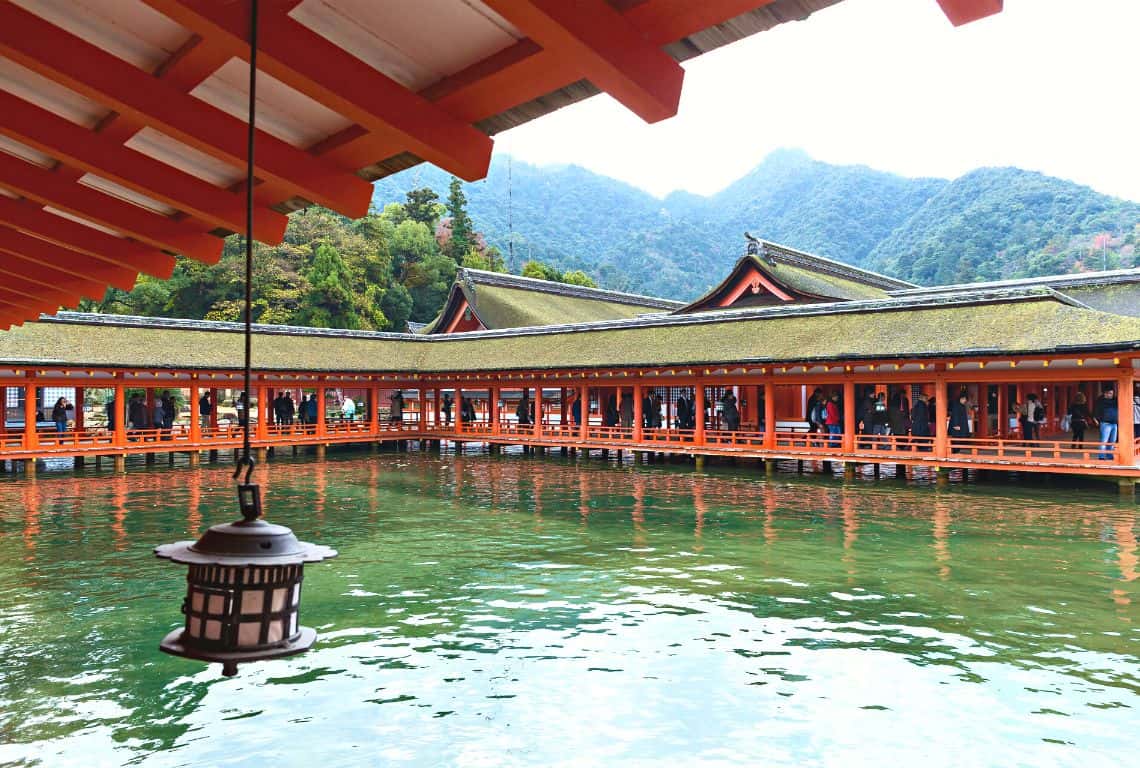
Itsukushima Shrine in Miyajima / Day Trips from Kyoto
3. Take Miyajima Island Ropeway to Mount Misen
Make sure to take the ropeway to catch the magnificent views of the island.
The ropeway leaves from Momijidani Station. You can take a bus to get to the station or you can walk. My recommendation is to walk.
It is no more than a 10-minute hike up a slight incline. Simply, take the path leading from Itsukushima Shrine to Momijidani Park.
The ropeway goes from Momijidani Station to Kayadani Station.
Once you reach Kayadani Station, you will take a second ropeway to your final destination which is Shishiwa Station.
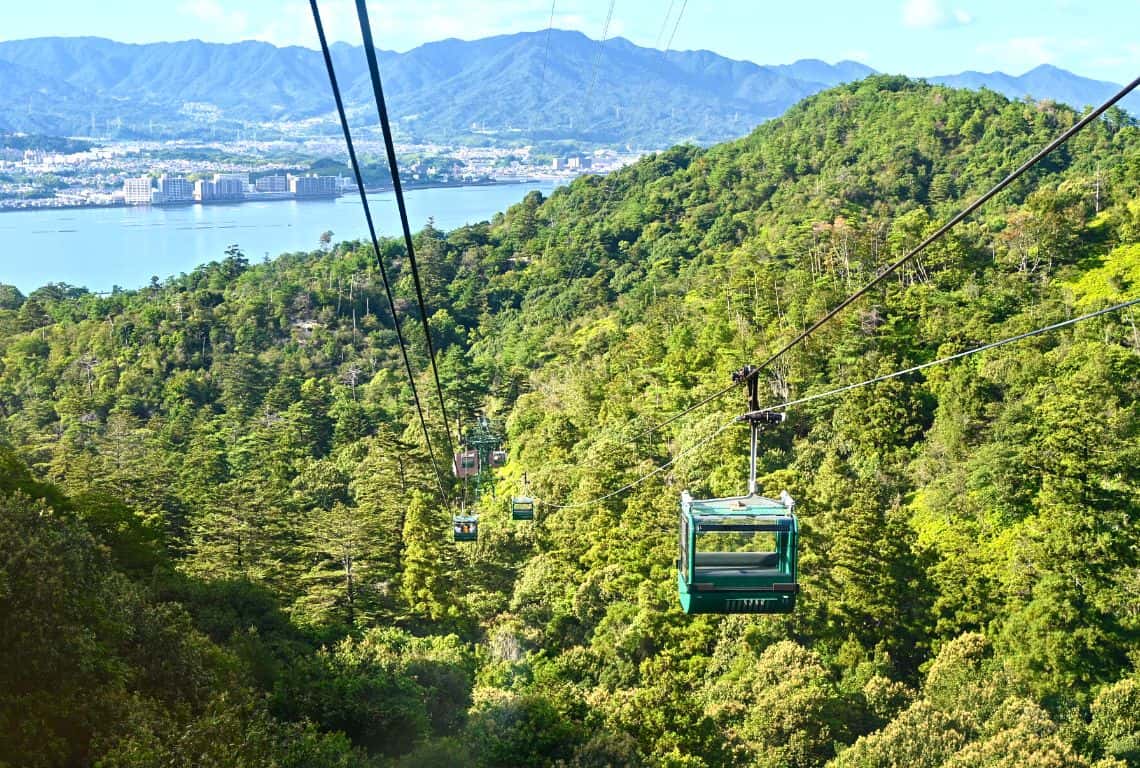
Miyajima Island Ropeway / Day Trips from Kyoto
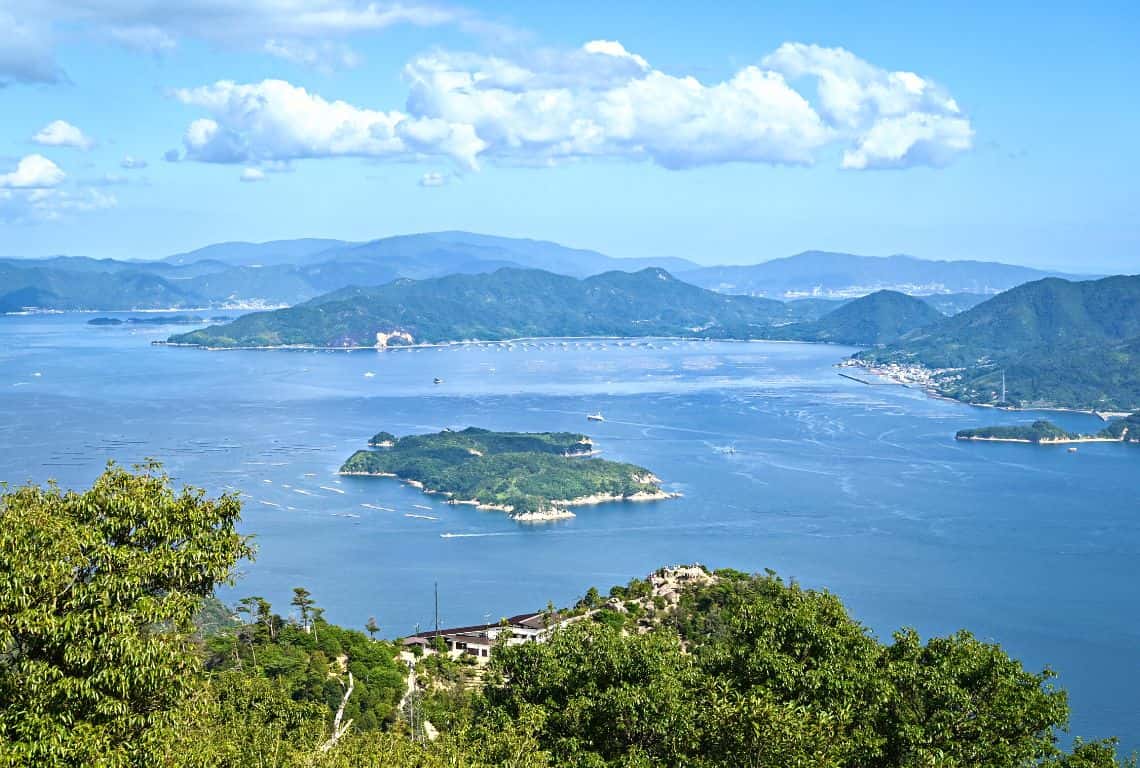
Views of Seto See from Mount Misen / Day Trips from Kyoto
There are more places to explore on Miyajima Island!
You should definitely explore Mount Misen. Mount Misen, situated 535 meters above sea level and offering spectacular views of the island and the Seto Sea, is an absolute must-do during your Miyajima Island day trip!
There are several ways to reach Mount Misen: you can hike. It is about a 1.5-hour hour hike from Momijidani Park. Or, you can take the ropeway to Shishiwa Station and then hike to Mount Misen.
Mount Misen has been considered a sacred place since ancient times. It is home to the seven wonders.
Finally, hands down, you must try some local delicacies. My recommendation is to go for grilled oysters with a bit of butter and soy sauce. So delicious!
Day Trip from Kyoto to Fushimi Inari Taisha
For many people, visiting Fushimi Inari Taisha in Kyoto is a major bucket list item during a trip to Kyoto or Japan, for that matter.
Fushimi Inari Taisha is world-famous for its Torii (Gates). It is said that there are over 10,000 Torii at Fushimi Inari. However, some sources claim that the number of Torii at Fushimi Inari is closer to 30,000.
Hands down, it is one of the most visually stunning places I have ever seen and if you are into photography, you will take a ton of pictures at every turn.
How to Get to Fushimi Inari Taisha on a Day Trip from Kyoto
Getting to Fushimi Inari is not hard and you can do it easily by using public transportation.
If you are at the Kyoto Station, then take the train along the JR Nara Line and get off at the Inari Station, which was the second station from Kyoto.
It is a short ride, maybe 5 minutes at the most.
Make sure to use your JR Pass for this ride. If you do not have a JR Pass, then buy it before going to Japan. You will save a ton of money. You can buy JR Pass here.
Just a note of caution here: several express trains are operating on the JR Nara Line and these trains do not stop at Inari Station. So, make sure to board the train marked Nara.
There are a couple of tours that you might want to check out:
Look into Fushimi Inari Hidden Hiking Tour. It is a guided hike that will take you through some hidden secret trails around Inari Mountain.
Small-Group Walking Tour of Fushimi Inari Shrine. It is about a 1-hour tour of Fushimi Inari. You will learn the history of the shrine, the role of foxes, and the meaning of the red gates.
What to See At Fushimi Inari Taisha on a Day Trip from Kyoto (3 Top Things You Can't Miss)
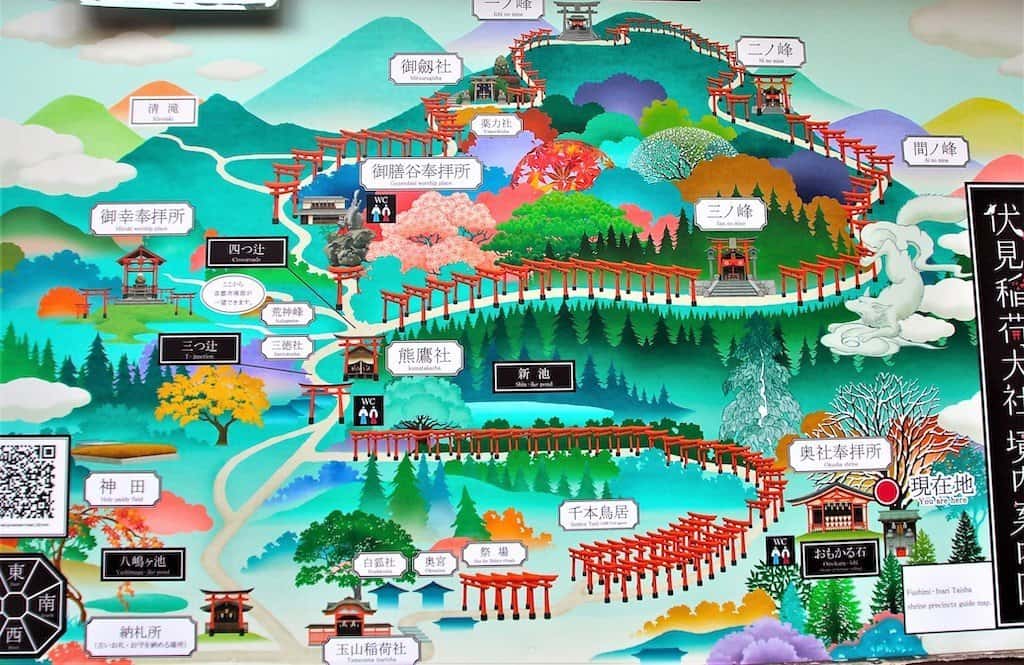
Map of Fushimi Inari Taisha / Day Trips from Kyoto
1. Stroll Through Thousands of Torii (Gates)
Torii are said to be the division between the physical and spiritual worlds.
They are donated by worshippers and they come in different sizes. The cost of Torii depends on its size. The large Torii could cost over one million yen.
Each Torii is inscribed with a donor’s name, alongside their wish for health, wealth, and prosperity.
Notably, each Torii gate lasts about 5 years. However, during that time it needs to be constantly maintained.
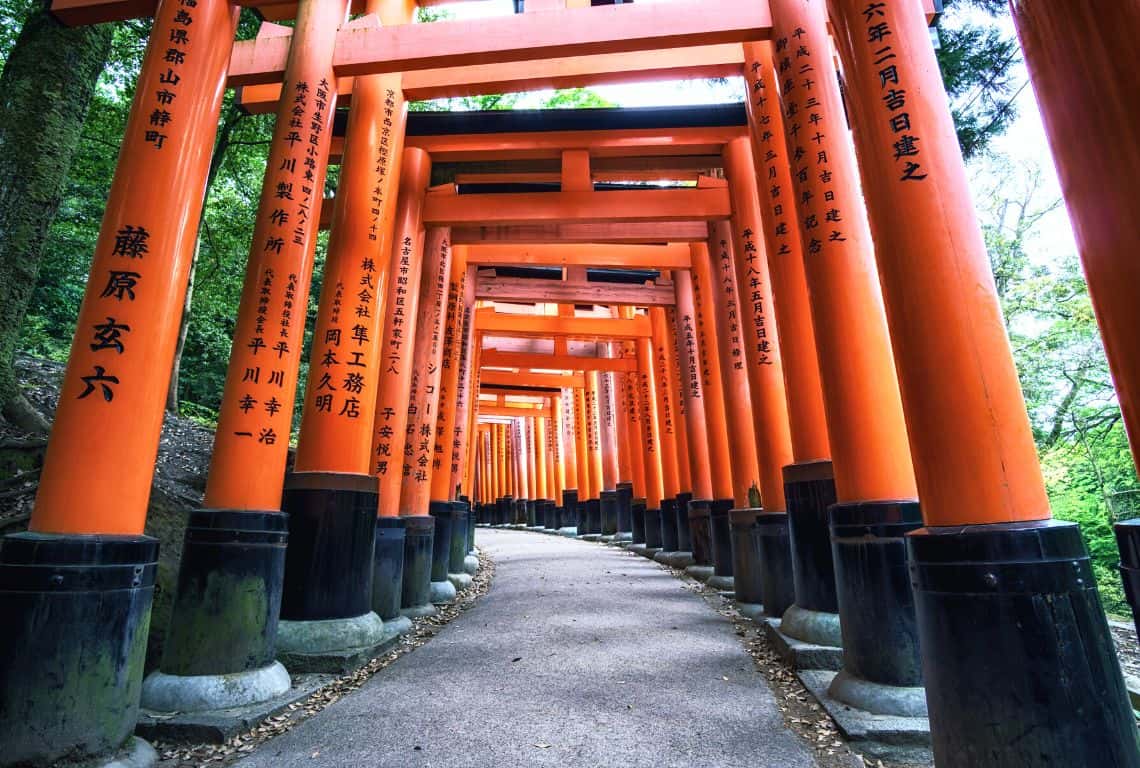
Fushimi Inari Taisha / Day Trips from Kyoto
Originally, the vermillion pigment was made from a powdered mineral called cinnabar. The pigment was used in the art and decoration in Ancient Rome, in the illuminated manuscripts of the Middle Ages, in the paintings of the Renaissance, and in the art and lacquerware in China.
In Japan, the vermillion color is meant to represent the color of the sun and the goddess Amaterasu which is the goddess of the sun. Amaterasu is the most important deity in the Shinto religion.
In addition, the vermillion color in the Shinto religion is supposed to expel evil spirits, obstruct magical powers and fend against diseases. It serves as a protection against misfortune and calamity.
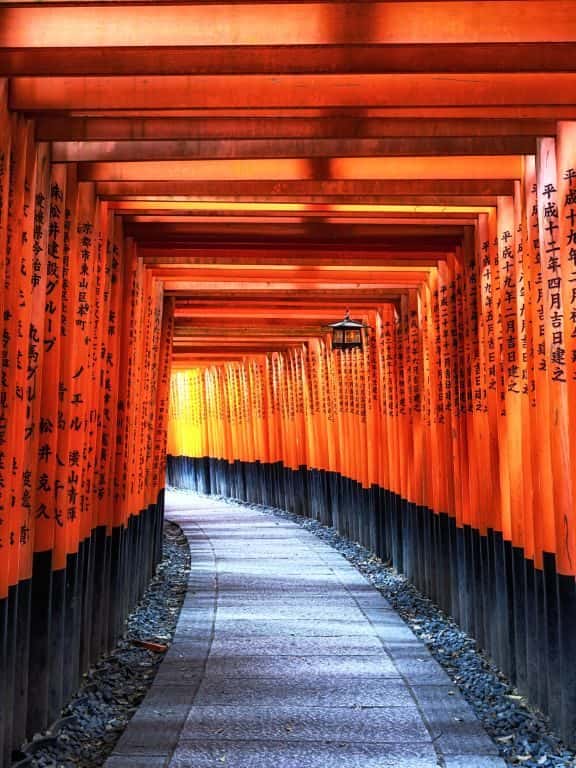
Fushimi Inari Taisha / Day Trips from Kyoto
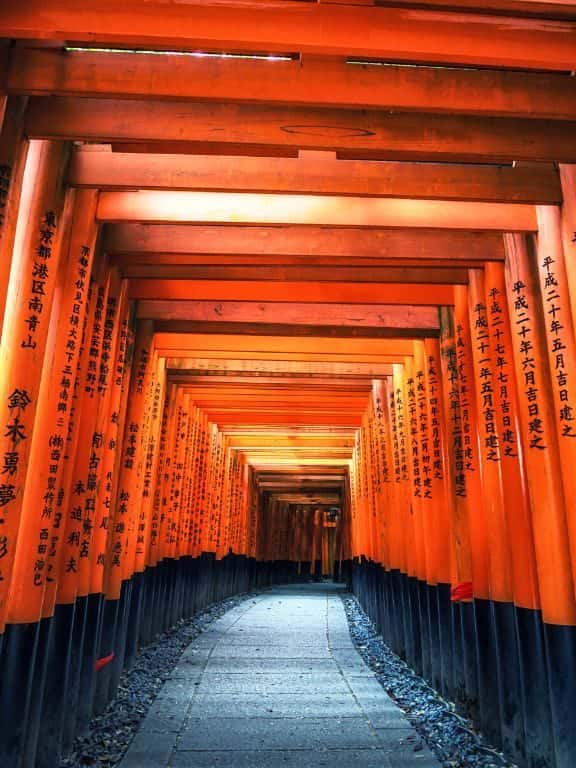
Fushimi Inari Taisha / Day Trips from Kyoto
2. Check out Fox Statues
There were hundreds of fox statues at Fushimi Inari Taisha. They are called kitsune in Japanese.
They are the messengers of the gods.
Some of the foxes that I saw, held a key in their mouth. The key represented their ability to unlock the rice granary and bring forth sustenance.
Some foxes had a scroll, which meant that the fox would bring wisdom to the recipient.
Some had bamboo, which symbolized plentiful harvest. Some held an orb, which meant spiritual power.
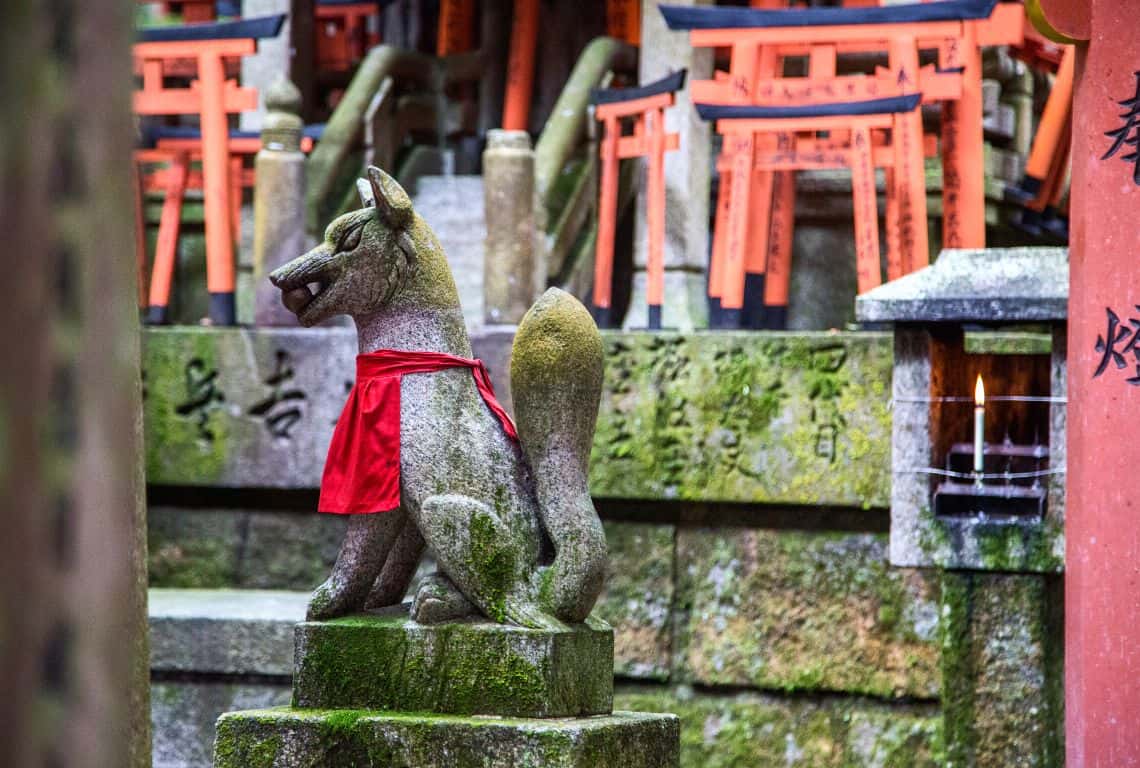
Fushimi Inari Taisha / Day Trips from Kyoto
3. Hike to the Top of Inari Mountain
One of the things you need to do while visiting Fushimi Inari Taisha is to hike to the top of Inari Mountain. It is a moderate hike that goes at a steady incline. It will take you no more than 1 hour to get to the top, however, reserve more time, because, you will be constantly snapping pictures!
There are several stations that you will reach along the way and each has special things worth exploring.
For example: when you reach the first station – Okusha Hohaisho, the inner shrine of Fushimi Inari, dedicated to the god of rice and sake by the Hata clan in the 8th century, you will see a box in front of the shrine and bells hanging from the awning.
If you throw a coin into a box and ring the bell, it is believed that these bells will summon kami – spirits, gods worshipped in the religion of Shinto, and let them know that you are here.
Right by the side of the shrine, you will find omokaru ishi – ‘light heavy stones’. Here, you can place a coin in the box, make a wish and then pick up the stone from the pile. If the stone is lighter than you thought, then the wish will be granted.
Inside the shrine, you will see ema – plaques in the shape of foxes’ faces. The worshippers draw the fox faces and give them different expressions. They write their wishes and prayers on the back of the ema.
There is more to learn and see at Fushimi Inari Taisha. Make sure to read my detailed post: Amazing Fushimi Inari Taisha (8 Things to Know Before You Visit)
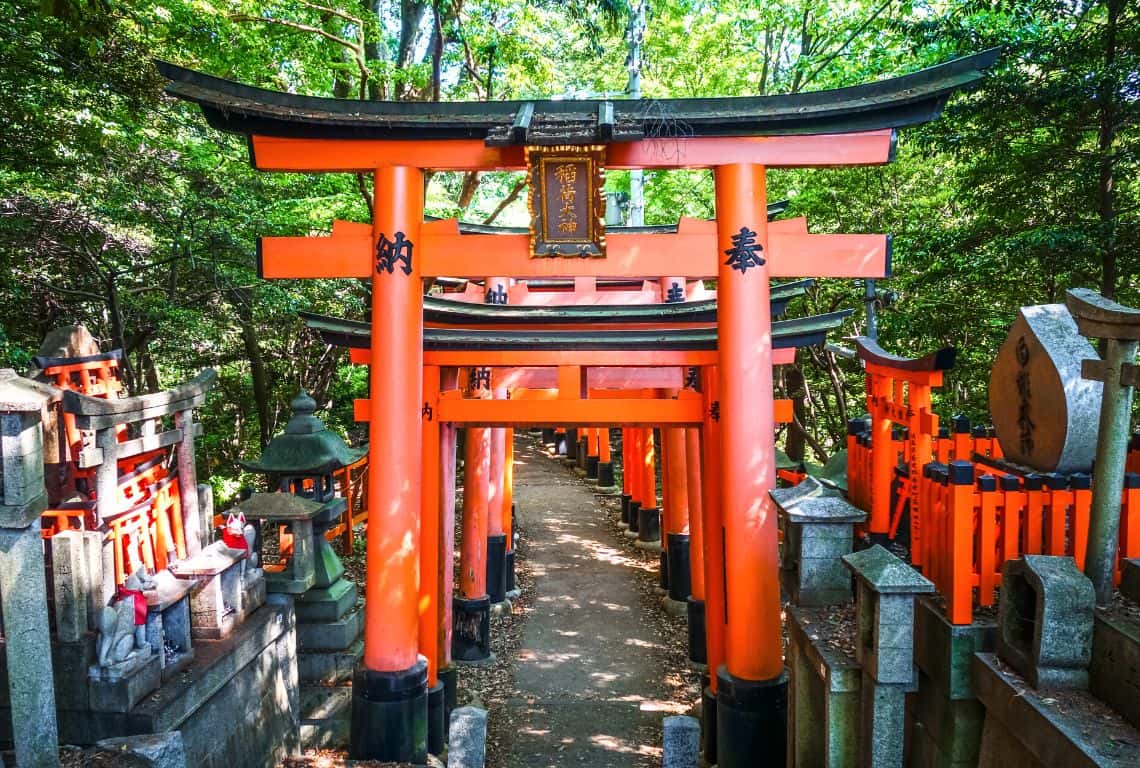
Fushimi Inari Taisha / Day Trips from Kyoto
Day Trip from Kyoto to Arashiyama
Arashiyama is a beautiful area located on the western outskirts of Kyoto.
There is so much to do in Arashiyama that your day trip from Kyoto will be absolutely fantastic! I listed here just 3 important things that you cannot miss, however, for a complete list of things to do in Arashiyama make sure to check out my post: 14 Amazing Things to Do in Arashiyama (Map+Useful Tips).
How to Get to Arashiyama on a Day Trip from Kyoto
Arashiyama (Storm Mountain) is a district located on the western outskirts of Kyoto, Japan.
There are several options for getting to Arashiyama from Kyoto:
- First of all, you can take Kyoto Bus #72 or #73 (Bus Stop C-6) from Kyoto Station and get off at Arashiyama. The cost of the bus ticket is 230 yen.
- Or, you can take the local JR Train from Kyoto Station to Arashiyama, specifically, to Saga Arashiyma Station. The journey time is 10-15 minutes depending on whether you get a rapid train or not. The cost of the train ticket is 240 yen.
If you have a JR Pass, then the cost of your ticket will be covered by the pass. You can purchase JR Pass here.
My recommendation is to check out this private walking tour of Arashiyama: Kyoto Arashiyama & Sagano Bamboo Private Tour with a Government-Licensed Guide. This tour is about 4 hours long and you will visit Arashiyama Bamboo Grove, Togetsukyo Bridge, Jojakko-ji Temple, and Tenryuji Temple.
While you are in Arashiyama make sure to go on a rickshaw ride! It is one of the best experiences you will have in Arashiyama! Check it out and book it here.
What to See in Arashiyama (3 Things You Can't Miss)
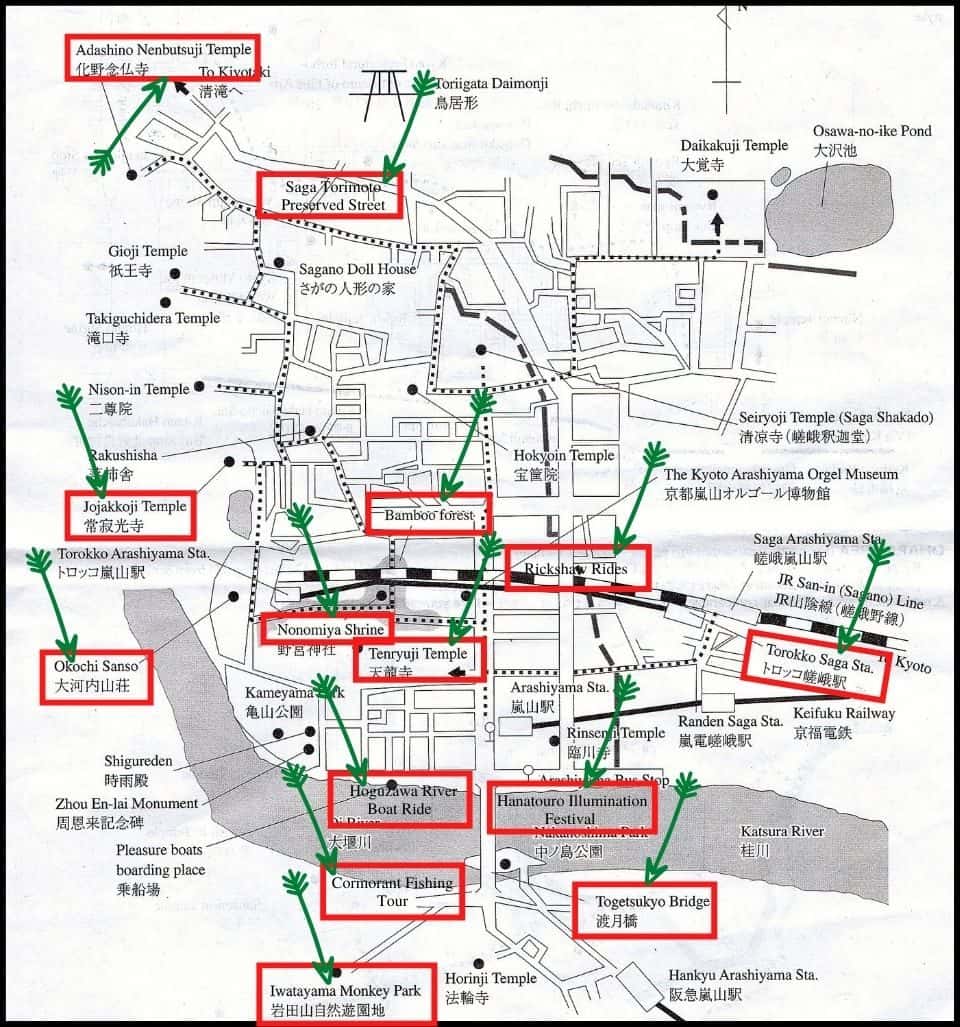
Map of Arashiyama / Image Credit: Japan National Tourism Organization / Things to Do in Arashiyama
1. Take a Walk Through Arashiyama Bamboo Grove
Hands down, one of the top things to do in Arashiyama is to take a walk through Arashiyama Bamboo Grove.
Arashiyama Bamboo Grove is a beautiful and peaceful bamboo forest. It looks absolutely amazing if there is a bit of sunlight filtering through the tall bamboo trees or if there is some light breeze that will make the stalks gently sway and let in the dappled light.
If you like photography, then this is the place to go! You will have a lot of fun taking pictures of this place.
Arashiyama Bamboo Grove / Day Trip from Kyoto to Arashiyama
2. Visit Tenryuji Temple in Arashiyama
Tenryuji Temple is no more than a 10-minute walk from JR Saga Arashiyama Station. Once you exit the station, go west and the temple complex will be right in front of you.
The temple was established in 1339 by the ruling shogun Ashikaga Takauji.
It is known that Takauji dedicated the temple to the memory of Emperor Go-Daigo.
Both, shogun Ashikaga Takauji and Emperor Go-Daigo used to be good allies until Takauji turned against the emperor in a struggle for supremacy over Japan.
After Emperor Go-Daigo passed away, Takauji built the temple to appease the former emperor’s spirits.
Tenryuji’s buildings were repeatedly lost in fires and wars over the centuries. Mostly, what we see today are buildings that date from the Meiji Period (1868-1912).
In 1994, Tenryuji Temple was registered as a UNESCO World Heritage Site, as part of the “Historic Monuments of Ancient Kyoto“.
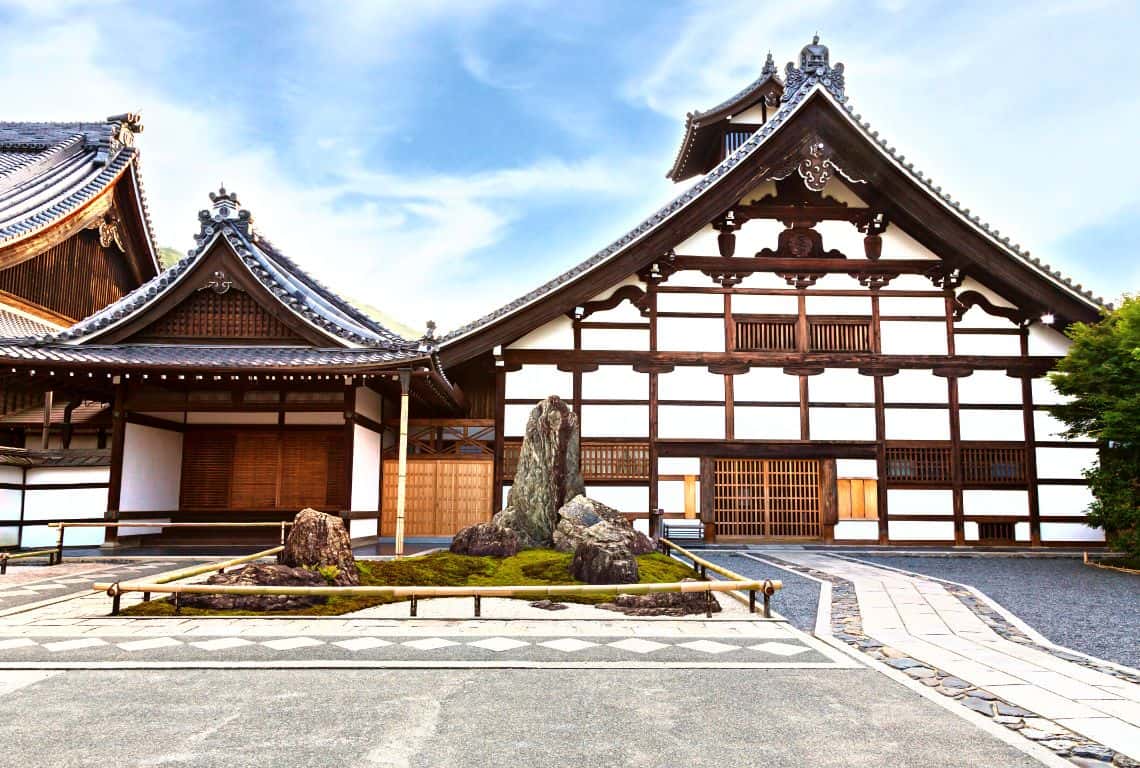
Tenryuji Temple in Arashiyama / Day Trips from Kyoto
There is a lot to see around the temple grounds. However, I think that you should visit:
- Hatto – Dharma Hall
- Kuri – Temple Living Quarters
- Hojo – Abbot’s Quarters
- Sogenchi Teien – Sogen Pond Garden
And, I do not want to be biased, but Sogen Pond Garden was the highlight for me!
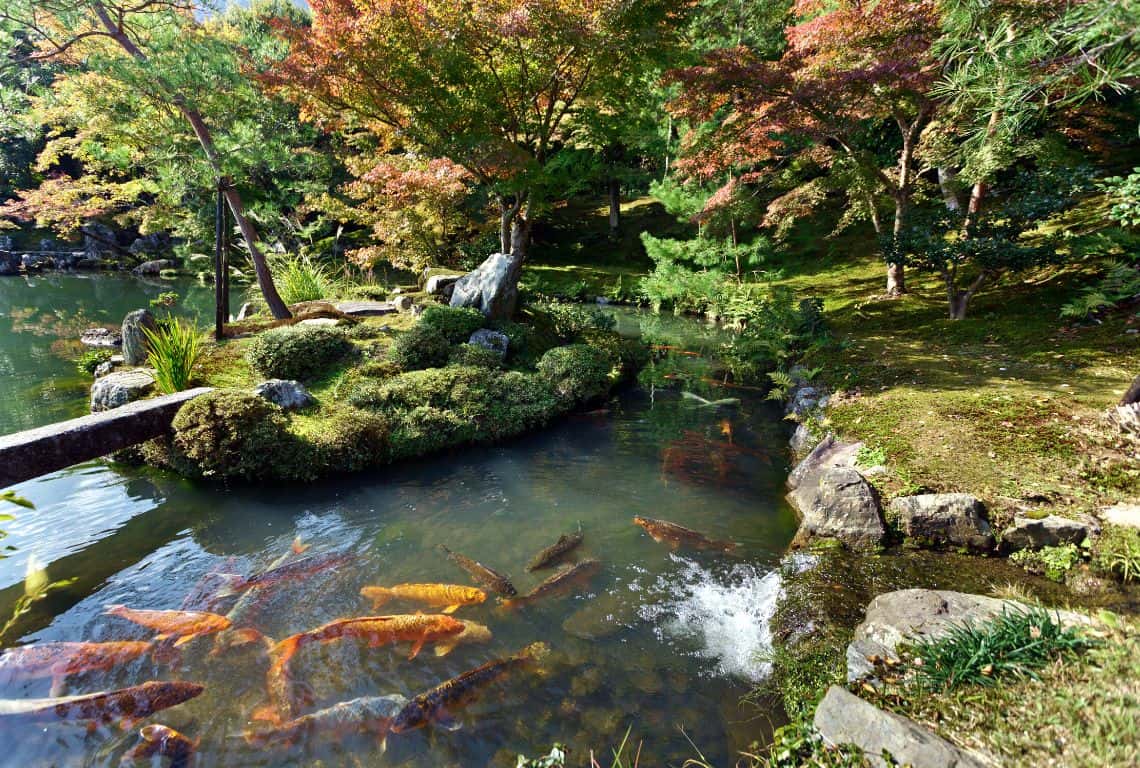
Sogen Pond Garden at Tenryuji Temple in Arashiyama / Day Trips from Kyoto
3. Explore Jojakkoji Temple in Arashiyama
Once you visit Jojakkoji Temple, you will agree that it is one of the best things to do in Arashiyama!
Jojakko-ji Temple is nestled on the slope of Mount Ogura. This Nichiren sect temple was opened in the late Momoyama period (14th century) by a monk who had used it as his retirement residence.
You enter the stunning grounds of Jojakkoji Temple through Sanmon Gate, which is the main gate. It is built with rectangular timbers arranged in beautiful latticework. The gate was renovated in the late Edo period (1603-1868).
Next, you continue on to the next gate – Niomon Gate, which served originally as the south entrance to the Guest Hall.
Afterwards, you will reach the Main Hall. This Main Hall was originally a Guest House of Momoyama Castle and it was moved to Jojakko-Ji Temple.
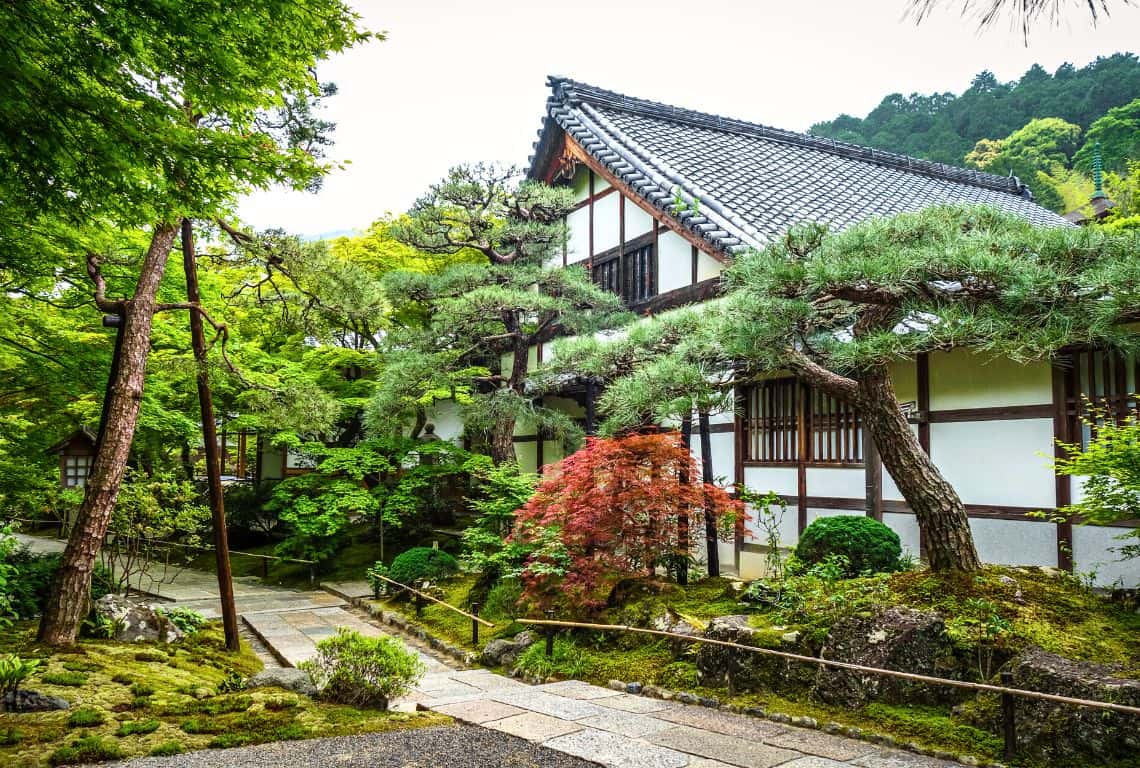
Jojakkoji Temple in Arashiyama / Day Trips from Kyoto
Day Trip from Kyoto to Hiroshima
If you plan a trip to Japan, then I am sure that Hiroshima is on your list of places to visit. And, Hiroshima is a perfect destination on a day trip from Kyoto.
Located on the western end of Japan’s main island of Honshu, Hiroshima is associated with the dropping of the nuclear bomb over the city at the end of the Second World War in 1945.
What can you see if you visit Hiroshima on a day trip from Kyoto? I came up with 3 must-see things you simply can’t miss. So check them out right below.
Before we dive in, make sure to read how to get to Hiroshima from Kyoto:
How to Get to Hiroshima on a Day Trip from Kyoto
If you have JR Pass and you are traveling from Kyoto, then take the Shinkansen Hikari from Kyoto to Shin Osaka in Osaka.
From Osaka at Shin Osaka, switch to Shinkansen Sakura for Hiroshima. The trip takes around 1 hour and 50 minutes from Kyoto.
Mizuho and Nozomi trains take 1 hour 25 minutes however, these trains are not covered by the pass.
What to See in Hiroshima (3 Things You Can't Miss)
Map of 3 Must-See Things in Hiroshima on a Day Trip from Kyoto
1. Visit Hiroshima Peace Memorial Park
Hiroshima Peace Memorial Park serves as a memorial to the people who were killed in the atomic bombing of Hiroshima on August 6th, 1945.
Designed by Japanese architect Kenzo Tange and opened to the public in 1954, the park has a total area of 122,00 square meters and houses a museum, numerous memorials, and monuments.
- Atomic Bomb Dome
The first stop in Hiroshima Peace Memorial Park is Hiroshima Peace Memorial (Genbaku Dome) – now commonly called the Atomic Bomb Dome or A-Bomb Dome.
The building was located just 160 meters from the epicenter of the blast and amazingly, it was one of the few structures in the area to remain upright.
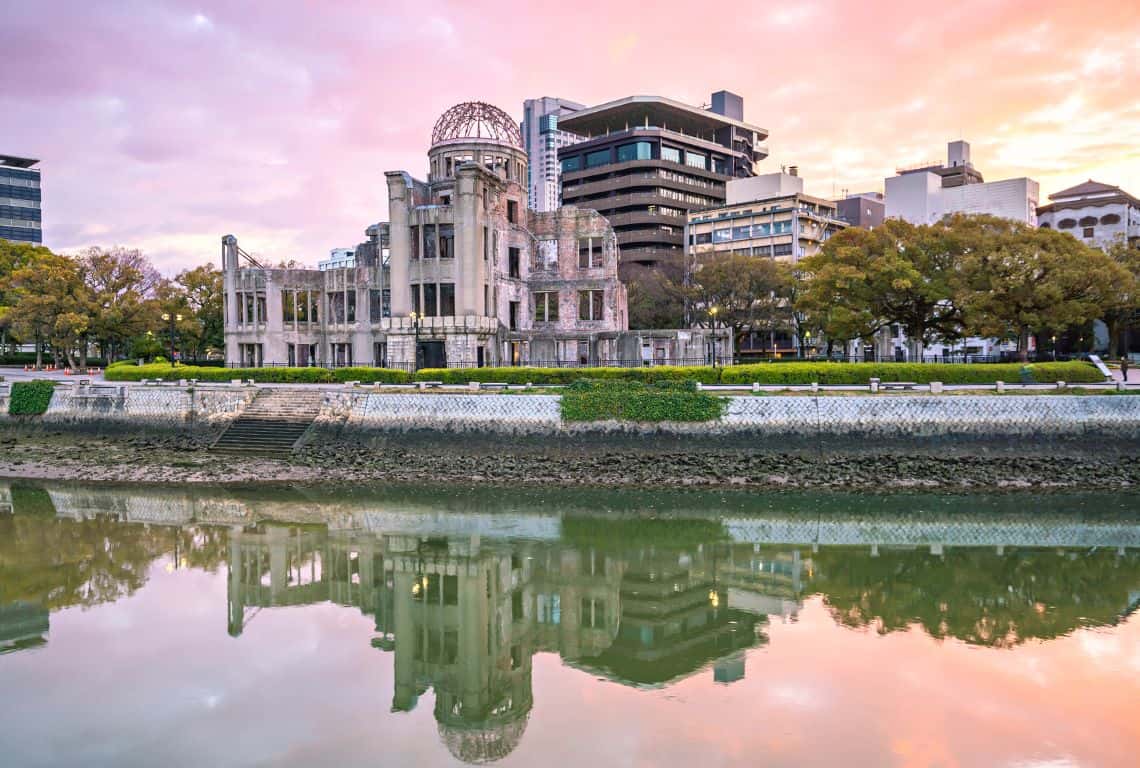
Hiroshima Peace Memorial Park / Day Trips from Kyoto
- Children’s Peace Monument
Next, make sure not to miss the Children’s Peace Monument. It is a tribute to Sadako Sasaki and all the children who perished in the atomic bombing of Hiroshima.
Sadako was exposed to the A-bomb at the age of two. Nine years later, she suddenly contracted leukemia and after an eight-month battle with the disease, she passed away.
Hiroshima Children’s Peace Monument is also known as the “Tower of a Thousand Cranes”. Sadako believed that if she folded 1,000 origami cranes she would recover. She continued folding them to the last moments of her life.
Today, paper cranes are known as the symbol of peace.
- Cenotaph
Finally, head over to Cenotaph, also known as the Memorial Monument for Hiroshima for the A-bomb Victims.
Cenotaph is located in the center of the park. It consists of a stone coffer beneath an arch. Within the coffer is a record of the names of victims of the atomic bombing.
Cenotaph is inscribed with the phrase: “Let all the souls here rest in peace for we shall not repeat the evil.”
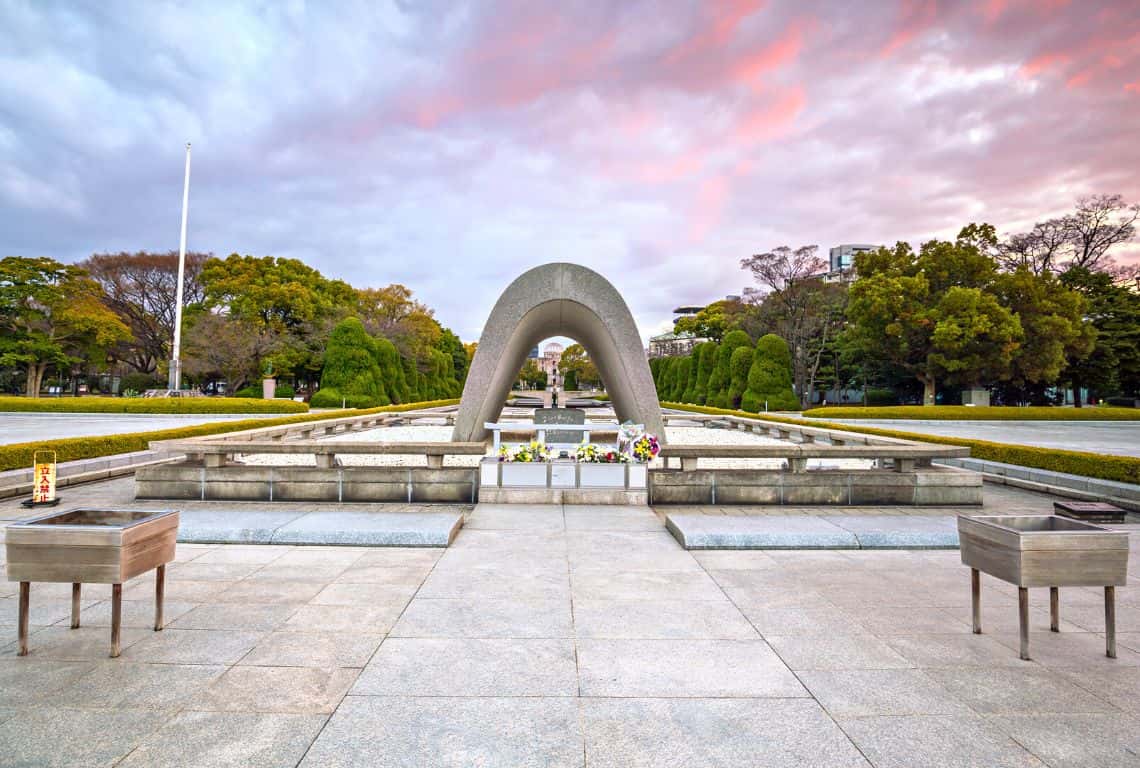
Hiroshima Peace Memorial Park / Day Trips from Kyoto
My recommendation is to stop by and visit Hiroshima Peace Memorial Museum.
The museum displays artifacts, photographs, and paintings that show Hiroshima before and after the bombing. The museum’s exhibits are poignant and evocative.
2. Explore Hiroshima Castle
Next, head over to Hiroshima Castle.
Hiroshima Castle is better known as Carp Castle (Rijou). It got its name from the black wooden slats attached to the outer walls of the Castle Tower that look like carp scales.
The castle was constructed by Mori Terumoto in 1589. The Fukushima family and the Asano family lived there during the Edo era.
Hiroshima Castle was destroyed on August 6th, 1945 during the atomic bomb attack. It was reconstructed and opened to the public in 1958.
Today you can tour the castle grounds and visit the five-story Castle Tower, which is a faithful reproduction of the original.
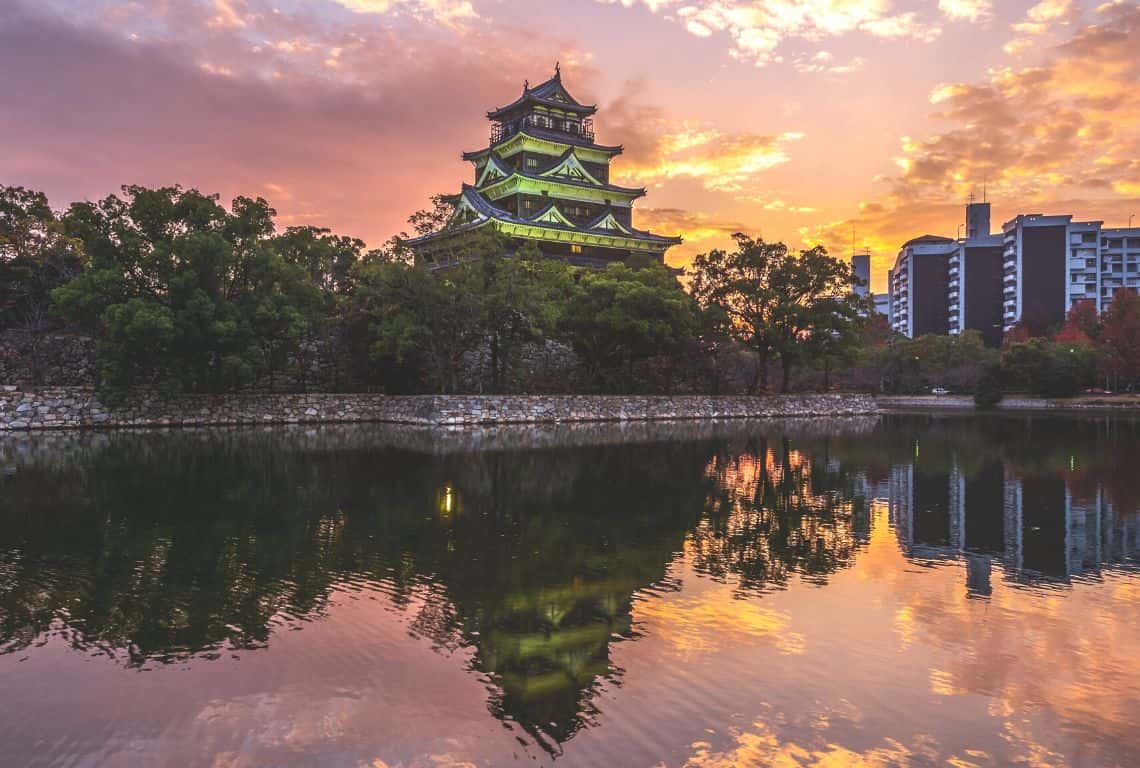
Hiroshima Castle / Day Trips from Kyoto
The Castle Tower houses a very good museum devoted to the history of Hiroshima. So, make sure to stop by and explore it!
One of the exhibits that caught my attention, was devoted to the differences in architecture between Japanese castles.
It explained the differences in the structure of castles built on hills called ‘hilltop’ or ‘mountaintop’ (for defense) castles versus the ones built on plains, called ‘flatland castles’ (mainly administrative).
Another great exhibit explained the differences in lifestyle between samurai and townspeople as well as the hierarchy of the feudal administration system.
Once you are done exploring the museum, head over to the top floor of the Castle Tower. It has an observation area where you can see an amazing panorama of Hiroshima.
3. Check Out Downtown Hiroshima
Hiroshima has a bustling downtown area situated around Hondori.
Hondori is a pedestrian arcade that is closed to traffic. It starts near Peace Memorial Park and runs east. It is lined with shops and restaurants and it is perfect for a stroll in the evening when it comes alive.
Downtown Hiroshima on a Rainy Evening / Day Trip from Kyoto to Hiroshima
Just south of the eastern end of Hondori is Okonomimura, translated as Okonomiyaki Village.
And, a visit to Okonomimra is one of the top things to do in Hiroshima.
Okonomimura is basically a four-story building decorated with lanterns and banners and a large horizontal “Okonomimura” sign.
It houses over 25 different stalls each offering its own unique rendition of okonomiyaki.
What is Okonomiyaki? Let’s start with the name – yaki means grilled or cooked, okonomi means “what you want” or “what you like.” In essence, okonomiyaki means “grilled the way you like it”. Hands down, you need to try Hiroshima Style Okonomiyaki!
Hiroshima Style Okonomiyaki / Day Trip from Kyoto to Hiroshima
Day Trip from Kyoto to Nara
One of the must-see sights when visiting Japan is Nara, the ancient former capital of Japan. Nara is a perfect day trip and can be easily done from Kyoto.
- Did you know that until the 7th century, Japan had no permanent capital?
The capital was moved with the passing of each emperor so that his successor would not be ill-fated by the death. The practice ended under the influence of Buddhism and with the Taika reforms of 646. However, the true aim of the reforms was to bring about greater centralization and enhance the power of the imperial court.
- The official capital was finally established in 710 and Nara, which was then known as Heijōkyō, was chosen as the site.
Nara remained the capital city until 784. The period between 710 and 794 is referred to as the Nara Period in Japanese history.
Interestingly enough, when a priest by the name of Dōkyō managed to seduce an empress and nearly usurp the throne, it was decided to move the court to a new location, out of reach of Nara’s increasingly powerful clergy. This led to the new capital being established in Kyoto, where it remained until 1868.
How to Get from Kyoto to Nara
Nara is a perfect destination on a day trip from Kyoto, and, there is nothing easier than to plan a day trip to Nara from Kyoto. You can do it! Here is how to get to Nara from Kyoto on a day trip: what you need to know is that there are two train lines that connect Kyoto with Nara, the JR Nara Line, and the Kintetsu Kyoto Line.
- JR Nara Line
If you have JR Pass, then you would want to take JR Nara Line. The cost of the trip will be covered by the pass. So, to start off, head to Kyoto Station and take the Miyakoji Rapid Train on the JR Nara Line. Miyakoji Rapid Train is the fastest connection between Kyoto and Nara. It only takes 45 minutes to reach JR Nara Station from Kyoto, if you take the rapid train.
I need to mention that there is Futsu local train which is covered by JR Pass as well, however, it stops by several stations on the way to Nara and the journey takes about 70 minutes.
- Kintetsu Kyoto Line
Kintetsu Kyoto Line is not covered by JR Pass, however, it is the fastest and most comfortable way to get to Nara. First of all, go to Kintetsu Kyoto Station and take the direct express (tokkyu) train on Kintetsu Kyoto Line. You will get to Kintetsu Nara Station in only 35 minutes.
By the way, JR Nara Station and Kintetsu Nara Station are within walking distance of each other and both stations are about the same distance from all the attractions.
What to See in Nara (3 Things You Can't Miss)
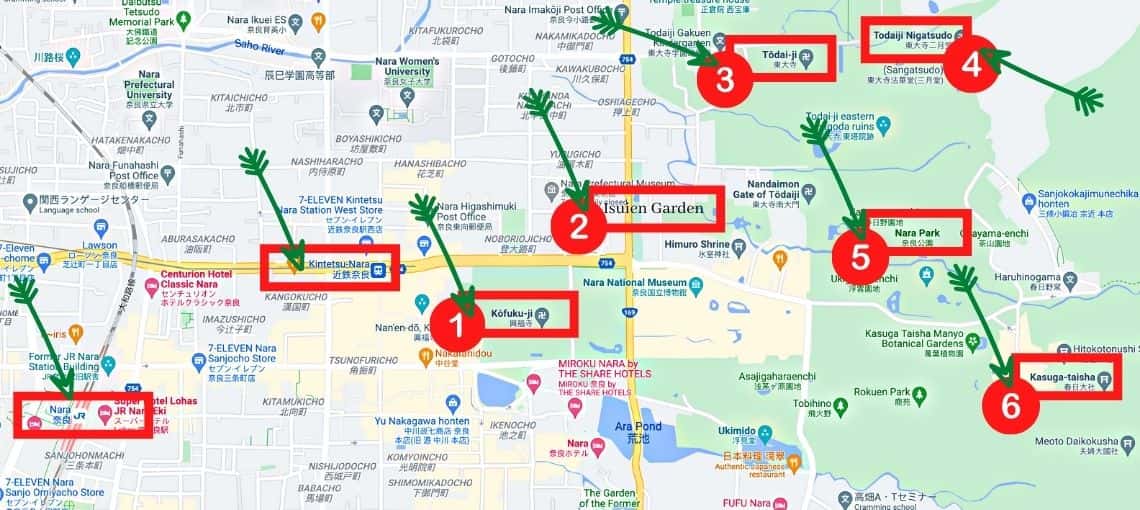
Legend: 1. Kofukuji Temple and Five-Story Pagoda, 2. Isuien Garden, 3. Todaiji Temple, 4. Nigatsudo, 5. Nara Deer Park, 6. Kasuga Taisha Temple
1. Visit Stunning Todaiji Temple in Nara
Nara Park is home to the 8th century Todai-ji Temple (Great East Temple), the most famous of the Seven Great Temples of Nara.
For one thing, Todai-ji is the most popular site in Nara. If you can only visit one place during your Nara day trip, then Todai-ji Temple is it!
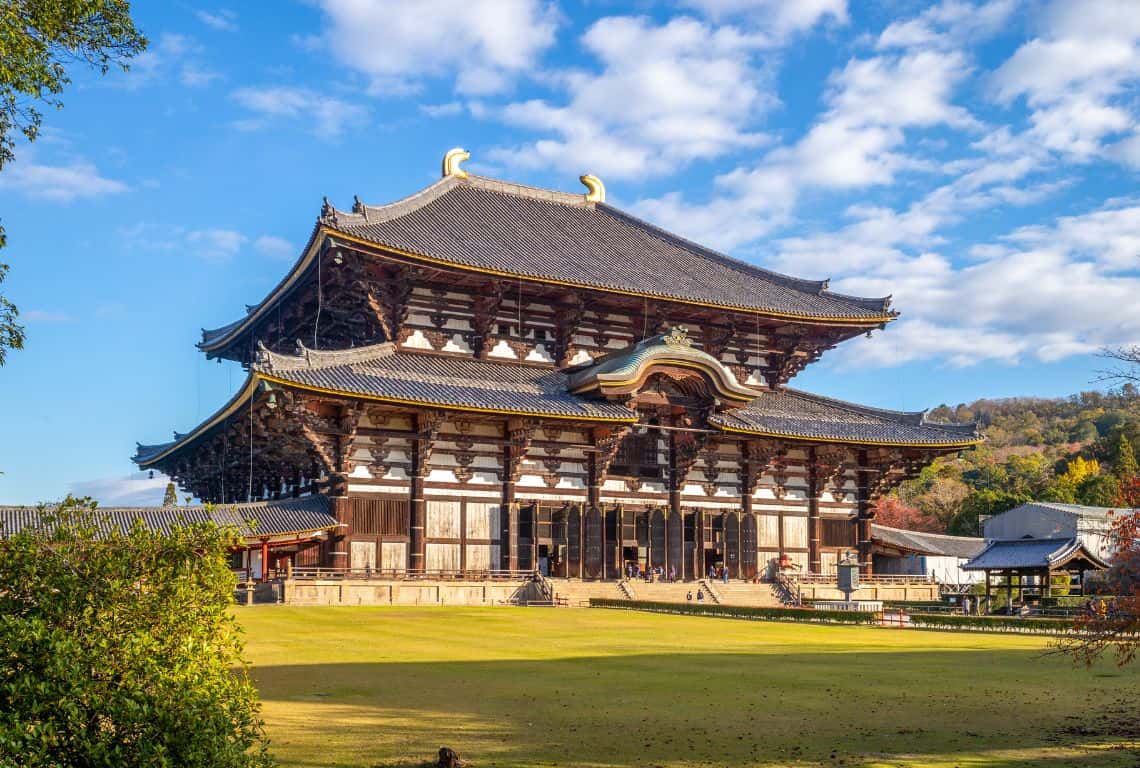
Todai-ji Temple in Nara / Day Trips from Kyoto
Leading to the temple is a splendid Nandaimon Gate. As you approach the gate, notice a unique plaque on top of it. It states that Todaiji is the main temple of the Kegonshu sect of Buddhism.
Next, step inside the gate. Subsequently, the gate houses two massive wooden statues. These are wrath-filled and muscular guardians of the Buddha known as Niō or Kongōrikishi. They are regarded as two of the finest wooden sculptures in Japan.
The statues were carved in the 13th century by the sculptors Unkei and Kaikei. They are about 30 feet high and particularly impressive at night when they are beautifully illuminated.

Todai-ji Temple in Nara / Day Trips from Kyoto
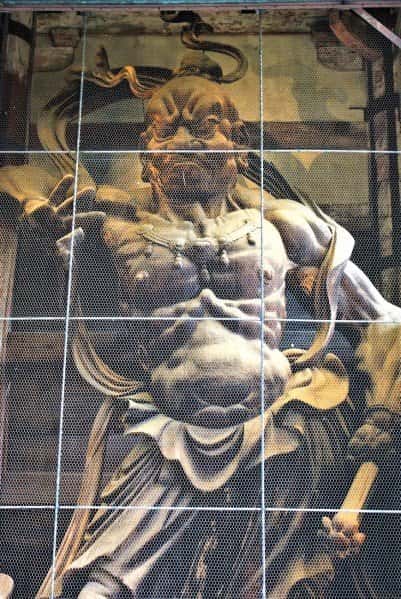
Todai-ji Temple in Nara / Day Trips from Kyoto
Next, you will be greeted by an immense Todaiji Daibutsuden, which is Great Buddha Hall.
It is hard to believe that the present structure is about one-third the size of the original temple which was built by Emperor Shomu in 741.
Todai-ji Daibutsuden was destroyed several times, first in 1180 and then again in 1567. It was rebuilt in 1709.
Also, did you know that Todai-ji Daibutsuden is the world’s largest wooden structure? Notwithstanding, it is a masterpiece! Notably, many of the crisscrossing beams are positioned without any nails.
Todai-ji Daibutsuden houses the world’s largest bronze Buddha (Daibutsusan). The great Buddha of Nara was originally constructed between 735 and 749. It is 49.1 feet high and weighs over 550 tons.
When the giant Buddha was constructed, all of Japan’s reserves of bronze and precious metals were used up!
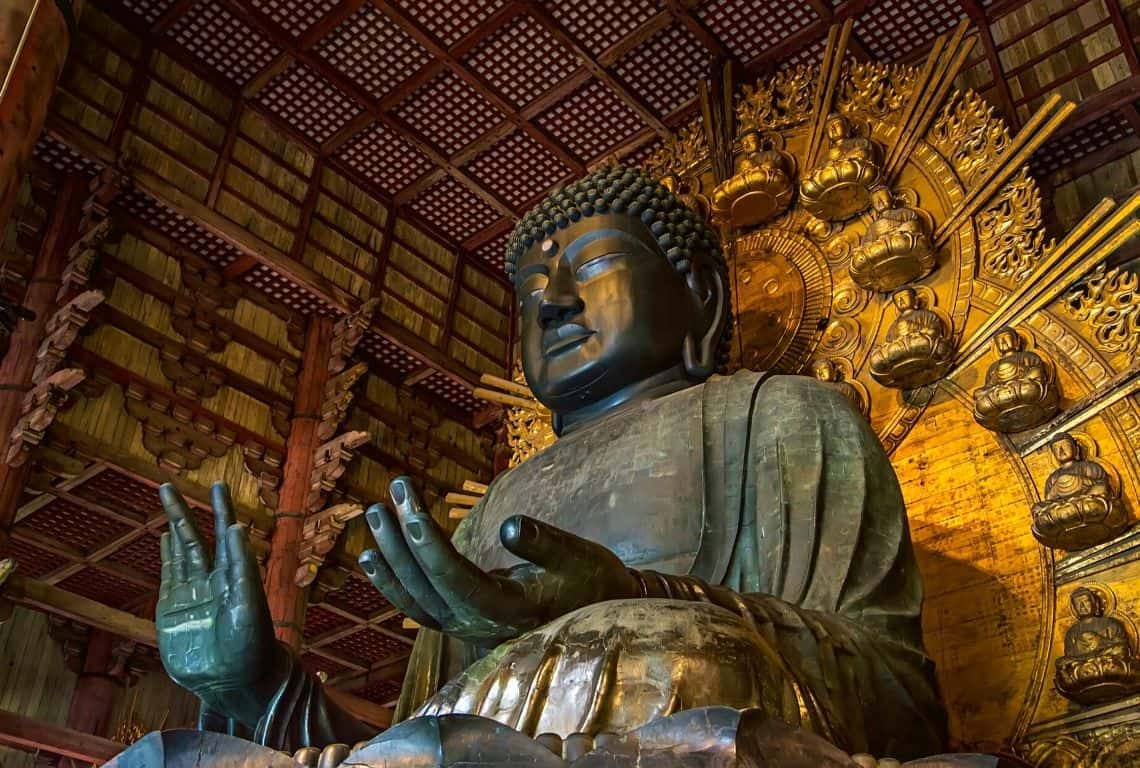
Todai-ji Daibutsuden in Nara / Day Trips from Kyoto
2. Have Fun Feeding Deer At Nara Deer Park
Nara is famous for its temples and shrines, however, on your Nara day trip you simply cannot skip the free-roaming Nara deer. They are just as popular!
By the way, there are hundreds of deer wandering through the vast lawns of Nara Park. Honestly, I thought that it would be rather hard to find them, when in fact, they are everywhere.
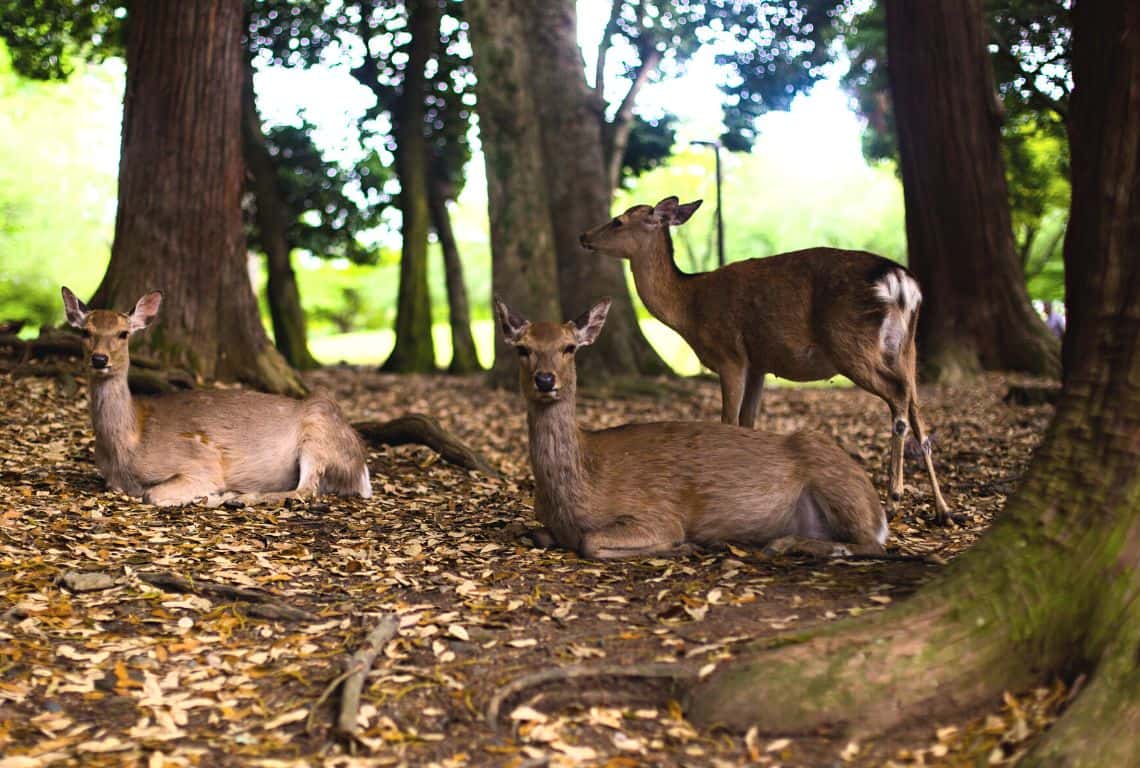
Nara Deer Park / Day Trips from Kyoto
Apparently, there are over 1,300 deer in Nara Park. These deer are called sika, which is derived from the Japanese word for deer: shika.
Legend has it that in 768 when the Fujiwara family established the great Kasuga Shrine in the foothills of the Wakakusa Mountain, a Shinto deity descended from the mountain to the new sanctuary riding a sacred white deer. Since then, the deer became a revered animal, protected by the authorities, and a symbol of the city.
Interestingly enough, until 1637, killing a deer in Nara was considered a serious crime, even punishable by the death penalty.
After WWII the divinity of deer was officially suspended, but they were declared a national treasure. Nowadays, they are protected and maintained in a semi-wild state which humans and deer use to mutual advantage.
3. Spend Time Exploring Kasuga-Taisha Temple
I have to honestly say that I love Nara and all the beautiful places in Nara, but Kasuga Taisha Shrine is my favorite place in Nara. Kasuga Taisha Shrine is top-notch!!!
The path leading to Kasuga Taisha Shrine is stunning. It is lined with thousands of aged, moss-covered stone lanterns.
The stone lanterns are known as “toro” and have been donated by worshipers as an expression of their faith.
And, be on the lookout for the deer peeking in between the lanterns!
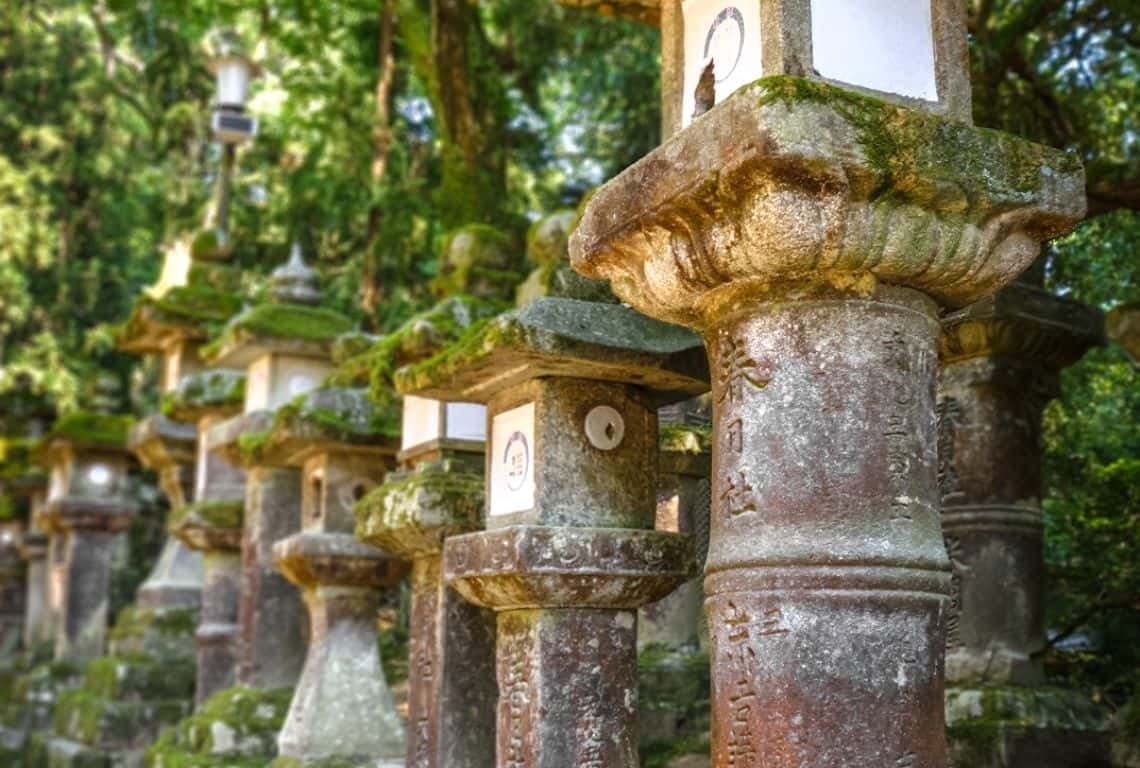
Kasuga Taisha Shrine in Nara / Day Trips from Kyoto
The path will eventually lead you to the vermilion-colored Kasuga Taisha Shrine.
The eves of the shrine are decorated with thousands of hanging brass and bronze lanterns; some new and brightly polished, some old and tarnished by time.
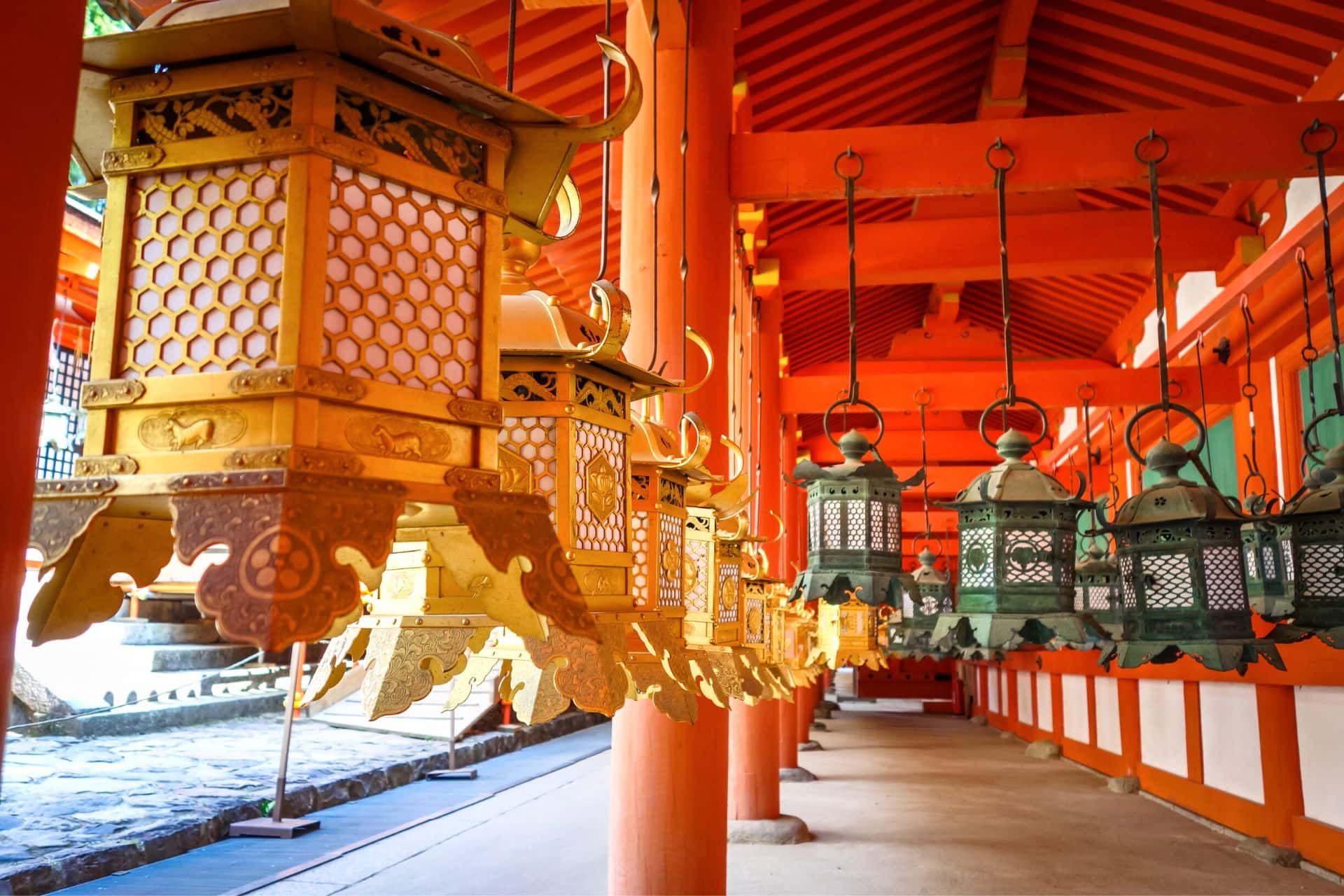
Kasuga Taisha Shrine in Nara / Day Trips from Kyoto
Day Trip from Kyoto to Kanazawa
Kanazawa is one of the most beautiful and historical cities in Japan. It lies just below the base of the Noto Peninsula, bordered by the Sea of Japan to the west and the Japanese Alps to the east. And, it is an absolutely perfect destination for a trip from Kyoto.
How to Get from Kyoto to Kanazawa
The best way to reach Kanazawa from Kyoto and most other cities on Honshu (Japan’s main island) is by train.
If you have a JR Pass, all the options of travel listed below are covered by the pass.
By the way, if you are planning a trip to Japan, then make sure to purchase a JR Pass before going. Having the pass will save you a lot of money! You can buy JR Pass here.
From Kyoto Station take JR West Thunderbird Express Train to Kanazawa Station. The travel time is 2 hours and 13 minutes.
What to See in Kanazawa on a Day Trip from Kyoto (3 Things You Can't Miss)
Map of Kanazawa with 7 Things You Should Not Miss
1. Check out Higashi Chaya District
I think that Higashi Chaya District is one of the most picturesque parts of Kanazawa. It is a part of Japan that is still untouched by time. You will feel like you stepped back in time when you are there.
First of all, ‘Chaya’ means tea house, and some of these traditional tea houses are still used as places of entertainment in Kanazawa.
Still even today, geisha perform dances and play traditional Japanese musical instruments, such as the shamisen (a three-stringed musical instrument), bamboo flute, and drum.
For one thing, Higashi Chaya District is a great place to just wander around for a while and soak up the ancient Japanese atmosphere.
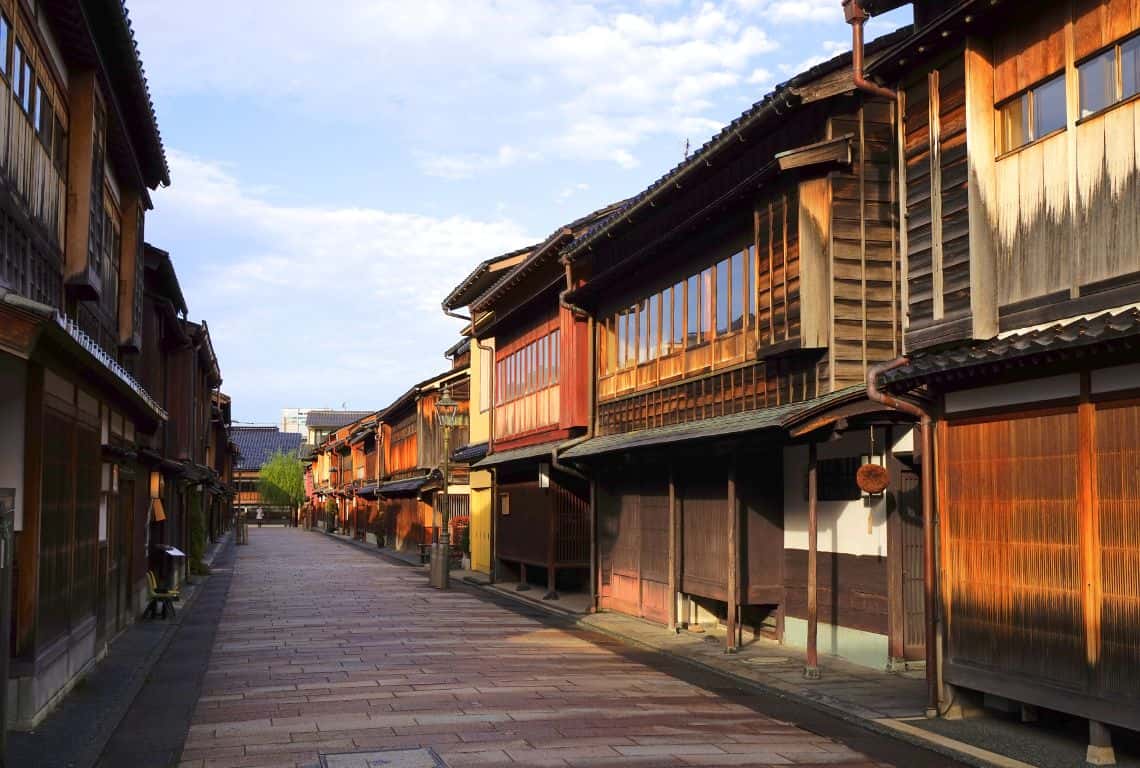
Higashi Chaya District in Kanazawa / Day Trips from Kyoto
2. Spent Time Strolling Through Kenrokuen Garden
Kenrokuen Garden is ranked by the Japanese as one of the top three most beautiful gardens in Japan.
In my opinion, it is a must-see place for any visitor to Kanazawa and one of the best things to do in Kanazawa no matter when you are visiting. You will be amazed by the beauty of this place.
Kenrokuen Garden gives an impression of naturalness. Yet, do not be misled. There is nothing natural about it. Kenrokuen Garden is a result of two centuries of dexterous remodeling of nature by the master gardeners of the feudal era.
And the final result is an expression of idealized nature where various elements of vegetation and topography are incorporated to enchant and surprise the senses.
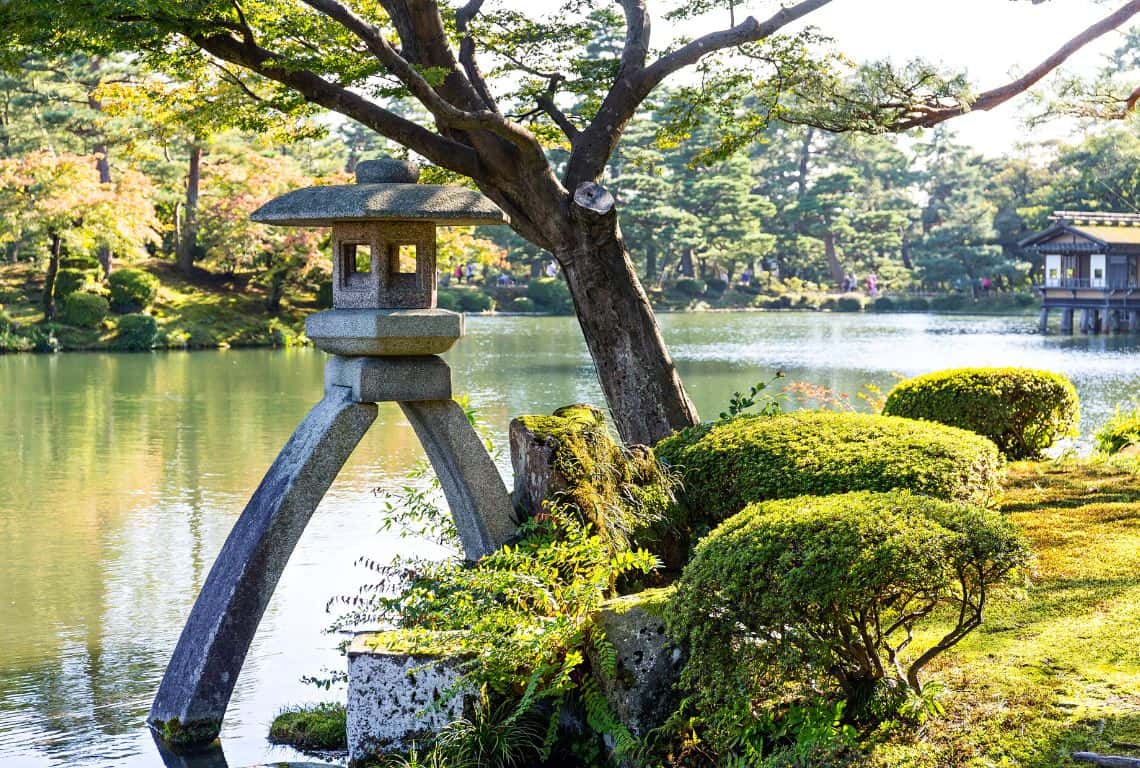
Kanazawa Station / One Day in Kanazawa
3. Visit Naga-machi Buke Yashiki District
Naga-machi Buke Yashiki District located in Kanazawa is the only samurai district still in existence in Japan.
To start your visit, take a stroll on the cobblestone streets and follow the path along the peaceful Onosho Canal.
The path is surrounded by old towering mud walls. The mud walls were made of mud mixed with gravel and then hardened. Today, the mud walls are covered with shingled roofs to shield them from the elements. In winter, they are protected with straw covers.
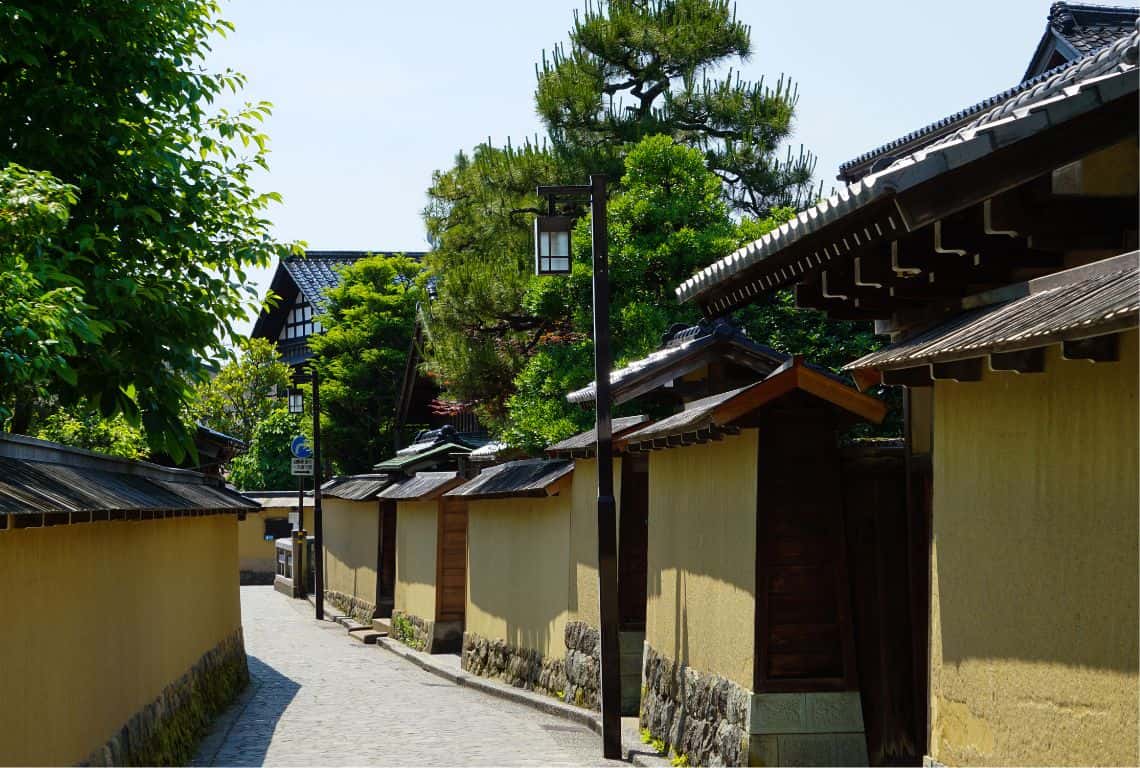
Naga-machi Buke Yashiki District / One Day in Kanazawa
While visiting Naga-machi Buke Yashiki District, you need to check out the Nomura Samurai House. It offers insight into the life of one of the highest-ranking samurai during the Edo Period.
The drawing room of the Nomura Samurai House is made of Japanese cypress wood with elaborate designs in rosewood and ebony.
The alcove panel is made of a paulownia tree and every nail is kept out of sight with black persimmon wood.
Every sliding thick-paper door has a grand landscape drawn by Sasaki Senkei, who is highly ranked in the Kano School.
Personal effects of the Nomura family are displayed including a samurai outfit, swords, lacquer pieces, and the family altar.
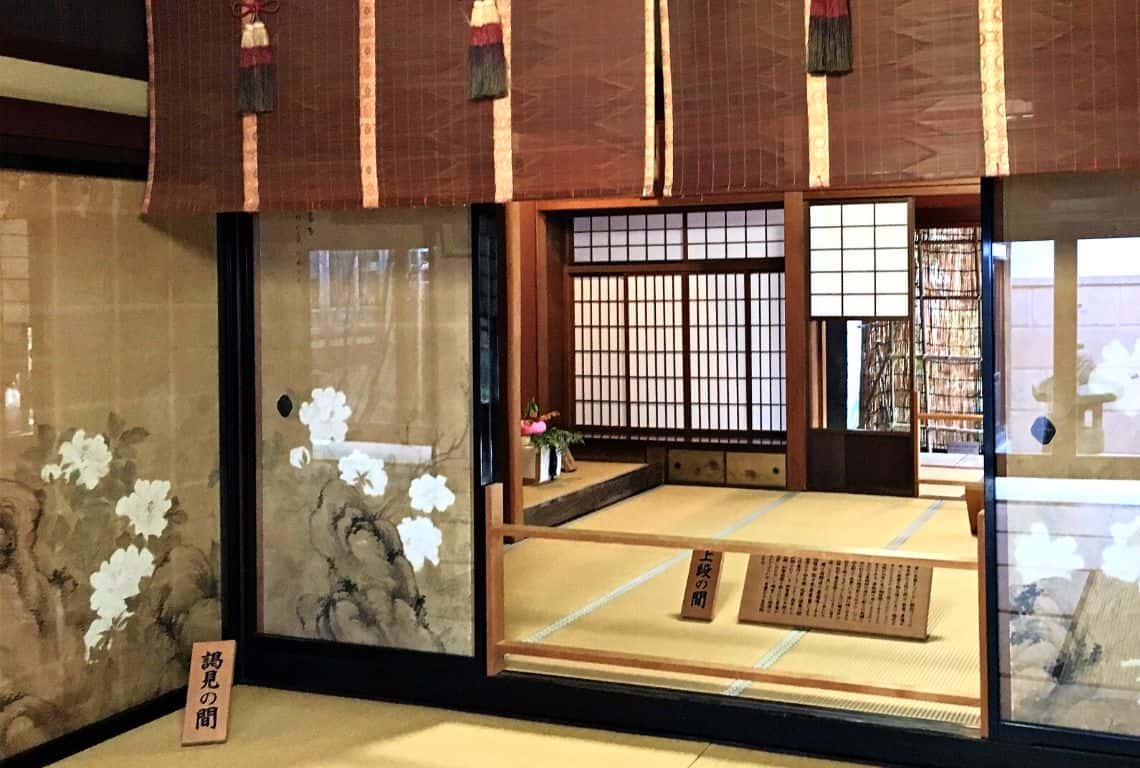
Nomura Samurai House in Kanazawa / Day Trips from Kyoto
Day Trip from Kyoto to Osaka
Osaka is one of a kind destination in Japan. It is not to be missed! The dazzling districts of Shinsekai, Dotonbori, and Shinsaibashi will have you in awe!
There is a lot to see in Osaka and you could easily spend a few days exploring this vibrant city and indulging in its culinary delicacies. However, here is a must-do list of attractions that can be easily accomplished in a day.
How to Get from Kyoto to Osaka
It is super easy to get from Kyoto to Osaka!
The JR Tokaido Shinkansen will get you to Shin-Osaka Station from Kyoto Station in about 15 minutes. JR Pass covers Hikari and Kodama trains between Shin-Osaka and Kyoto, but it does not cover Nozomi trains.
What to Do and See in Osaka on a Day Trip from Kyoto (3 Things You Can't Miss)
Map of One Day in Osaka Itinerary / Day Trips from Kyoto
1. Visit Shinsekai District
Shinsekai is Osaka’s razzle-dazzle glitz overload you can’t miss!
The delicious smells of cooked food, the flashing and buzzing lights, the huge signboards, and the crowds make you feel like you just stepped into a Blade Runner movie.
However, you are really in an old retro part of Osaka that is unlike any other area in Japan. It feels almost overwhelming to be here, yet strangely alluring. Shinsekai is a must-visit when in Osaka!
Shinsekai in Osaka / Day Trips from Osaka
While in Shinsekai, you need to try kushikatsu! It is Shinsekai’s culinary forte.
Kushikatsu is a deep-fried breaded skewered meat, seafood, or vegetables.
The neighborhood abounds with kushikatsu stands that are on almost every corner of Shinsekai offering various kinds of meat, fish, and vegetables all breaded and deep-fried on small sticks for around 150 yen each.
When you walk around the Shinsekai district, you will easily spot the popular good luck Billiken statue.
You can find him literally on every corner, at all souvenir shops, or in front of restaurants, or there is even a shrine dedicated to him.
Many believe that rubbing Billiken’s feet will bring you good luck.
Go to the top of Tsutenkaku Tower!
Tsutenkaku Tower is the symbol of Osaka. Translated into English means building leading to heaven, or tower reaching to heaven.
Tsutenkaku was constructed in 1912 and its inspiration was the Arc de Triomphe and the Eiffel Tower.
The tower stands at 103 meters and it has two observation levels. The indoor observation level and the outdoor observation deck. The views of Osaka are pretty spectacular.
2. Check out Dotonbori District
Dotonbori is basically a street located along the Dotonbori River. It is usually packed with crowds to the brim. All the shop fronts have bright, flashing, and colorful displays trying to get your undivided attention.
In addition, there are hundreds of food stalls preparing and selling sizzling delicacies. Make sure to try takoyaki and okonomiyaki.
Do not miss the famous Kani Doraku billboard. It is right by the Ebisubashi Bridge. The enormous crab is an attention-getter for the restaurant specializing in crab dishes.
Kani Doraku is famous for its kanisuki (5,000 yen) sukiyaki-style crab hotpot.
If 50,000 yen for a crab hotpot is not in your budget, then try some grilled crab that Kani Doraku sells right in the front of the restaurant. It is delicious!
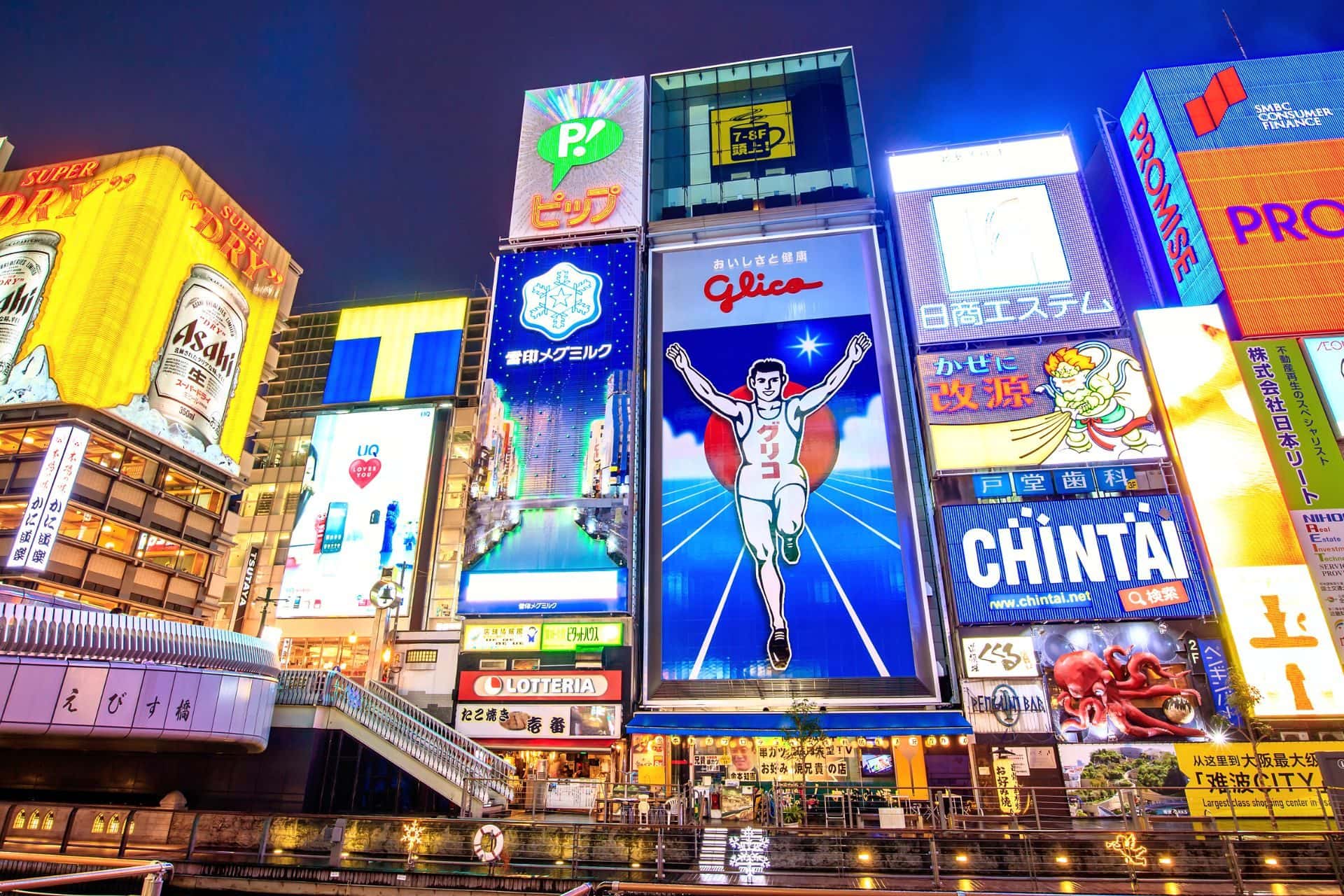
Dotonbori in Osaka / Day Trips from Kyoto
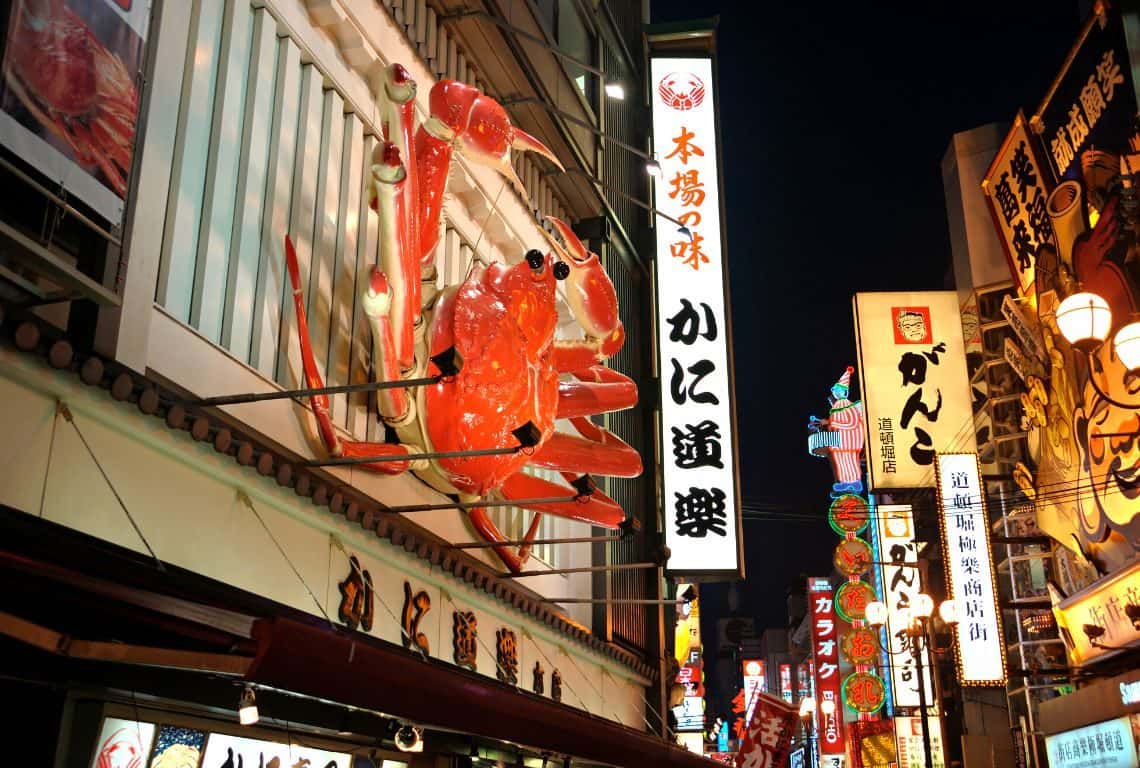
Dotonbori in Osaka / Day Trips from Kyoto
3. Sample Local Delicacies at the Famous Kuromon Market
Kuromon is an undercover market about 600 m in length. It comprises around 200 shops that offer absolute food galore ranging from sushi and sashimi, grilled scallops and crabs, to seared Kobe beef, not to mention the freshest white strawberries.
Kuromon Market will tease your taste buds and fill your tummy. In addition, hold on to your wallet if you are on a budget because you will simply overspend.
Kuromon Market in Osaka / Day Trips for Kyoto
What to eat at Kuromon Market? Here are my 3 top things to try:
- Have you ever tried uni? If it is still on your list of things to try, then you should not wait any longer and give it a taste. Kuromon Market is a perfect place to try it.
To begin with, I would describe the texture as creamy or buttery, silky, and delicate with just a slight firmness. Secondly, the aroma is like a clean ocean smell. Thirdly, the taste: it has an almost ineffable flavor; ever so slightly sweet, clean, and crisp and it lingers on. Finally, its color is beautiful – shades of gold, yellow and orange.
- Next, try grilled scallops.
To tell you the truth, I love grilled scallops! And, you will fall in love with them as well, if you head to Uofuku. In fact, Uofuku is hard to miss because there will be a crowd surrounding the tiny stall and the smell of grilled seafood will hit you almost immediately.
- Finally, you absolutely must try o-toro, which is the fattiest and most desired section found on the underside of the tuna belly.
You will find a lot of shops selling Nigiri, which is a specific type of sushi consisting of a slice of raw fish over pressed vinegared rice, and sashimi, which refers to just slices of very fresh fish served raw, often over a bed of shredded daikon radish.
I suggest you make your rounds and select the place that draws the biggest crowd and prepares the food right in front of you.
All in all, O-toro is delicious. It is rich and creamy. It kind of evaporates while you indulge in it.
Kuromon Market in Osaka / Day Trips from Kyoto
Intrepid Scout's Tips for Day Trips from Kyoto
That is quite a few day trips from Kyoto! What if you had time to do just one or two trips from Kyoto? Which trip should you choose?
- My recommendation is to visit Fushimi Inari. It is a unique and visually stunning place that will leave you in total awe. I have visited many places around the world, and when I am asked which one was the best, I often mention Fushimi Inari.
- My second choice would be Osaka. It is not to be missed if you are planning your trip to Japan. Make sure to visit Dotonbori and Shinsaibashi, as well as Shinsekai.
More Information About Japan:
14 Amazing Things to Do in Arashiyama (Map+Useful Tips)
What to See at Nijo Castle in Kyoto (10 Top Things to Know)
Stunning Golden Pavilion in Kyoto (How to Visit and What to See)
Amazing Fushimi Inari Taisha in Kyoto (8 Things to Know Before You Visit)
First Visit to Kyoto – How to Visit and What to See (11 Things You Can’t Miss)
Perfect Day Trip to Miyajima from Kyoto, Osaka, or Hiroshima
10 Amazing Things to Do in Hiroshima You Can’t Miss of Your Visit
Perfect One Day in Kanazawa – 7 Things to Do (Great Day Trip from Tokyo, Kyoto, or Osaka)
19 Amazing THINGS to DO in HAKONE (Useful Maps+Photos+Practical Tips)
You Might Also Like:
275 Best QUOTES About JAPAN (JAPANESE Culture, Nature, Food, Anime, Proverbs)
Did You Find Day Trips from Kyoto Useful?
Why Not Save It to Your Pinterest Board!
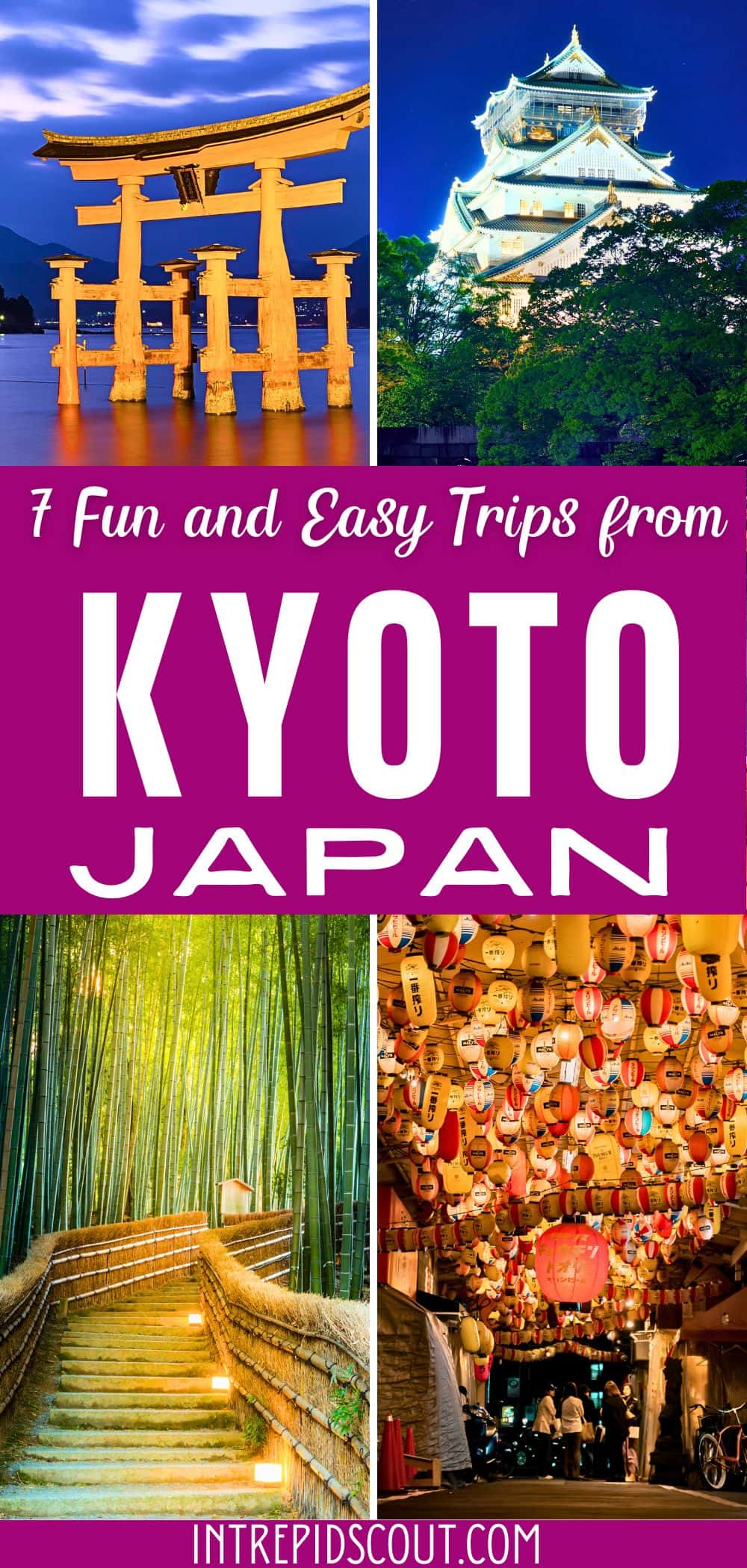
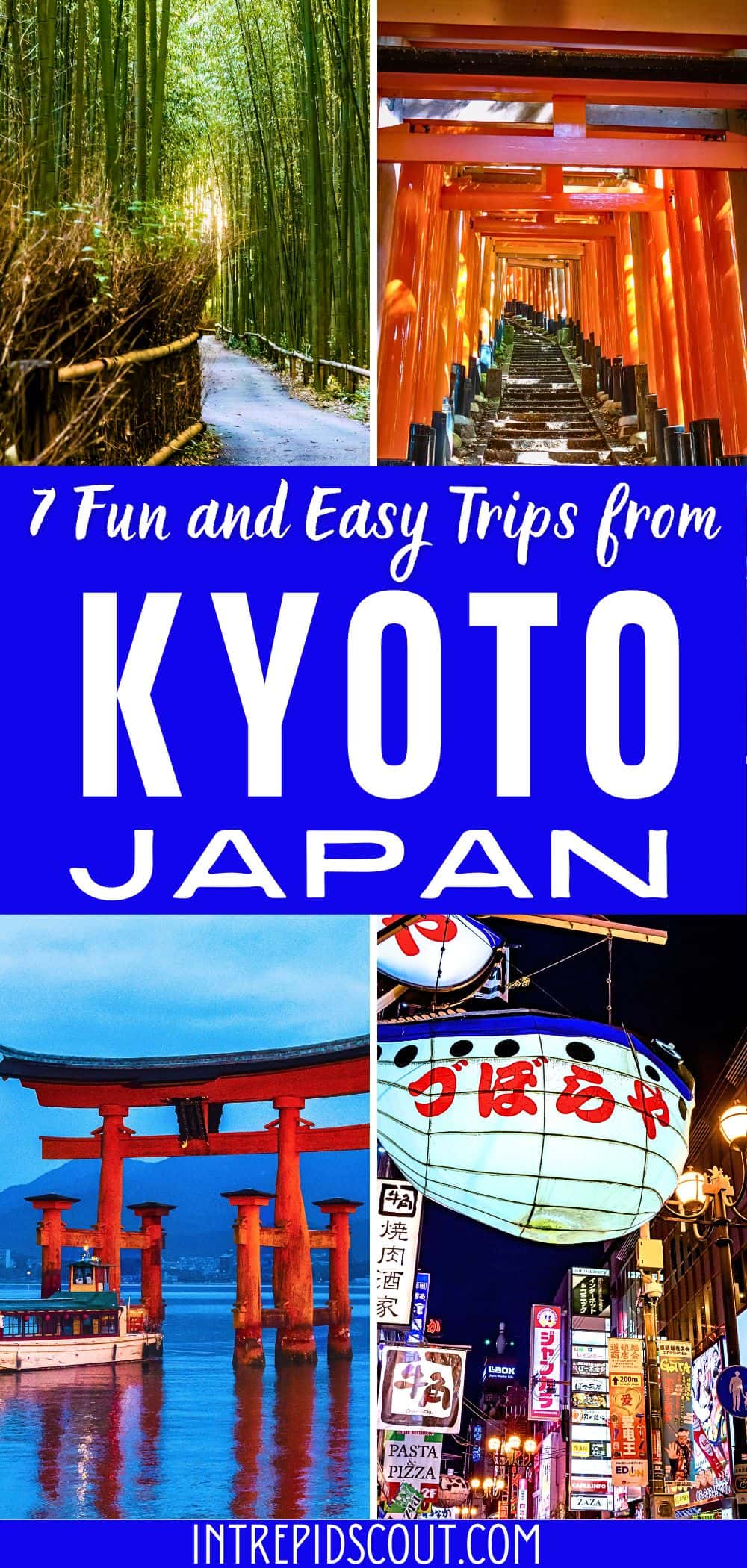
Now, It Is Your Turn, I Would Like to Hear Back from You!
Are you planning your trip to Kyoto? Will you do any day trips from Kyoto?
Please let me know! Drop me a quick comment right below!
Click on any of the images below to get inspired and to help you with the planning process for your trip to Japan!

